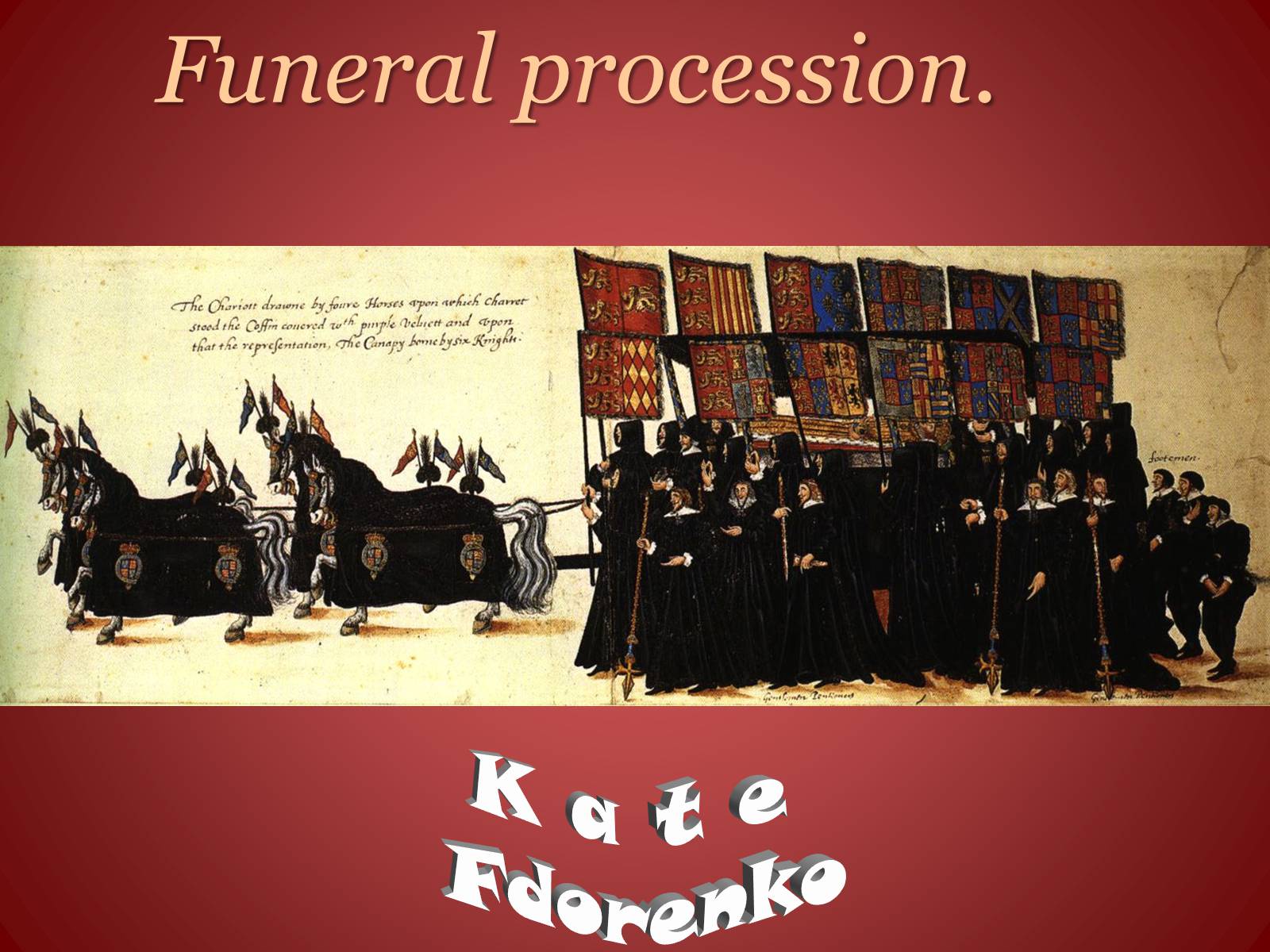- Головна
- Готові шкільні презентації
- Презентація на тему «Elizabeth I Tudor»
Презентація на тему «Elizabeth I Tudor»
223
Слайд #1
Elizabeth I Tudor
The Golden Age
The Golden Age
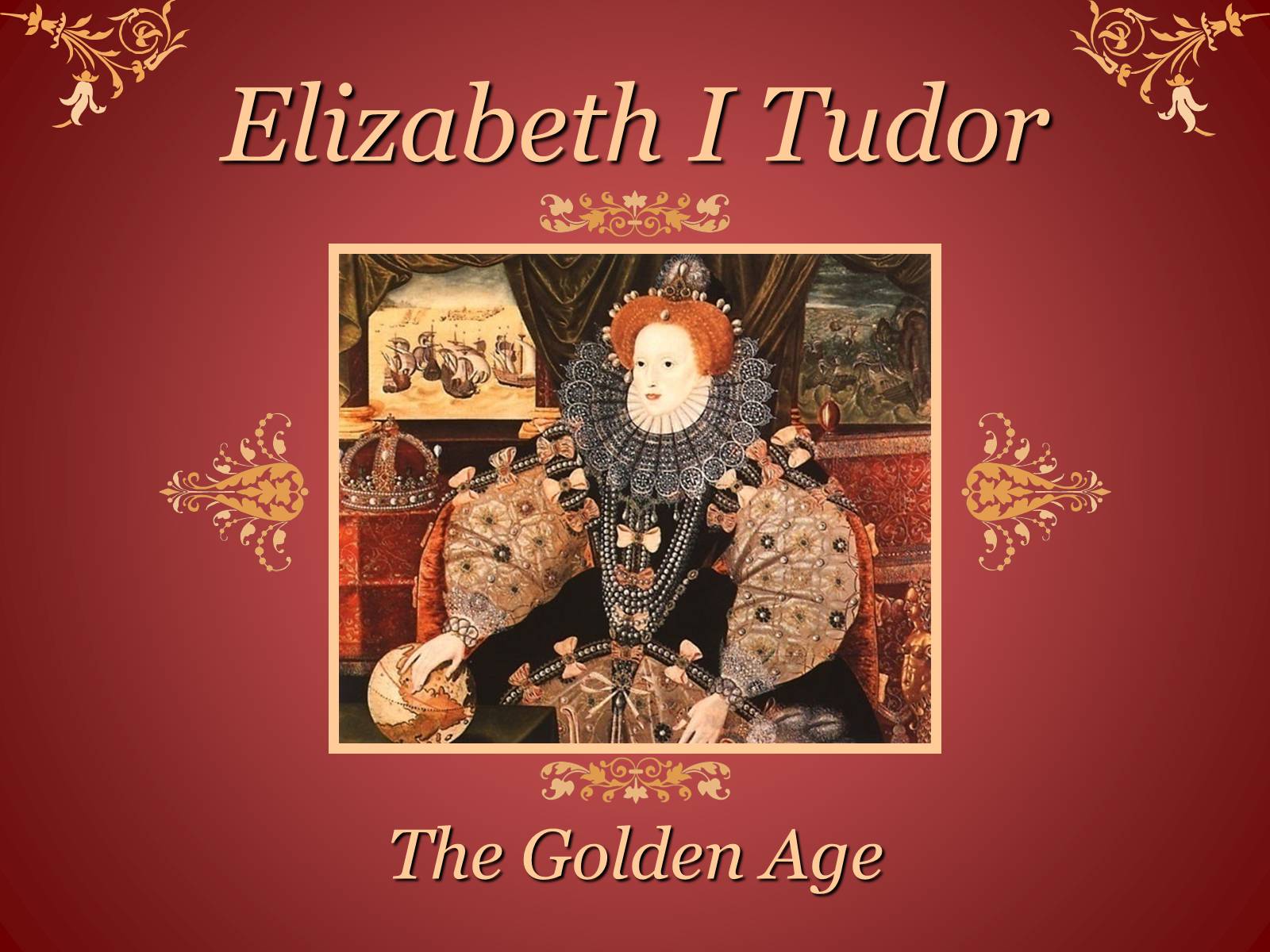
Слайд #2
Henry VIII (1491-1547 )
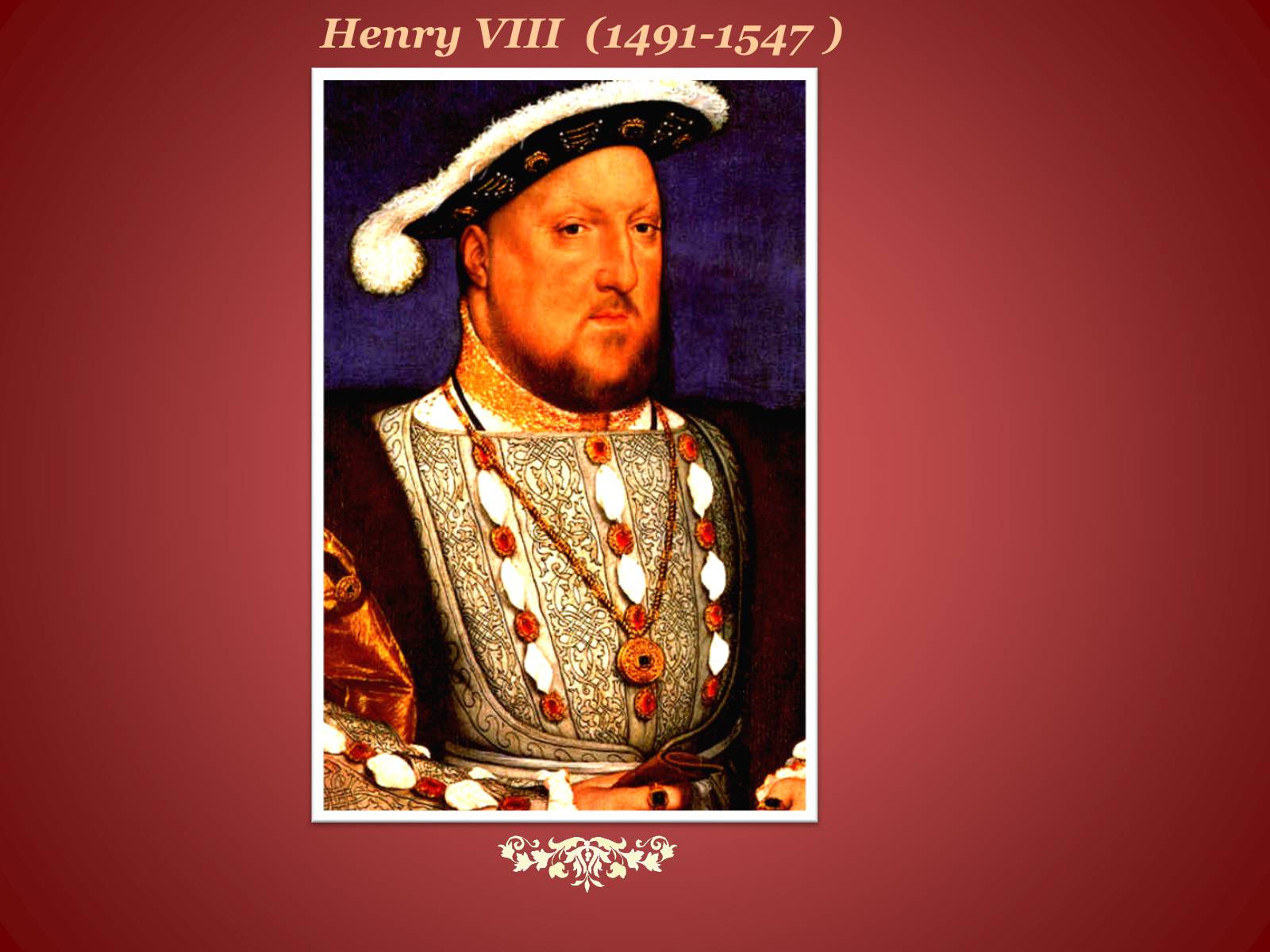
Слайд #3
Catherine of Aragon
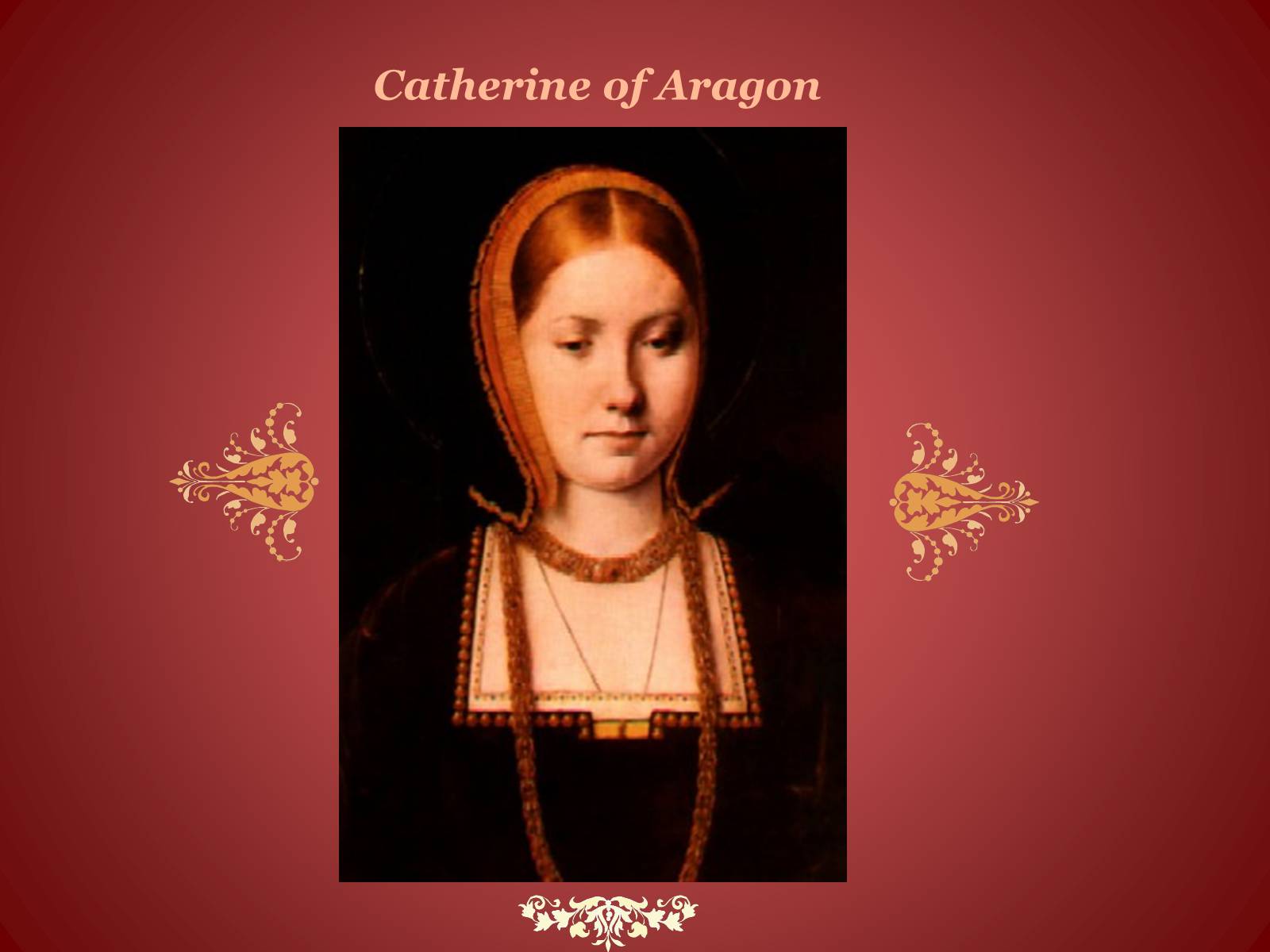
Слайд #4
Anne Boleyn
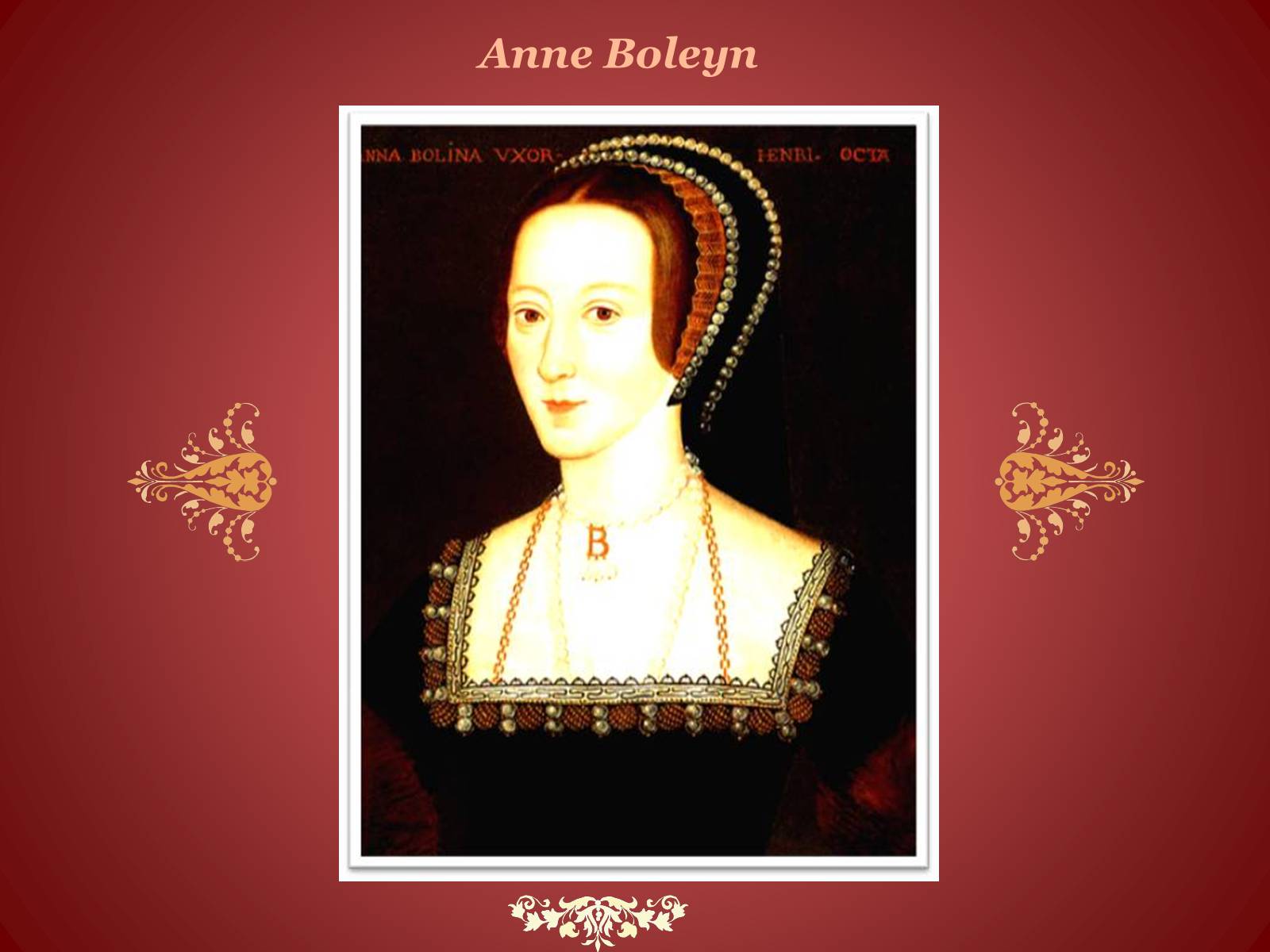
Слайд #5
Jane Seymour
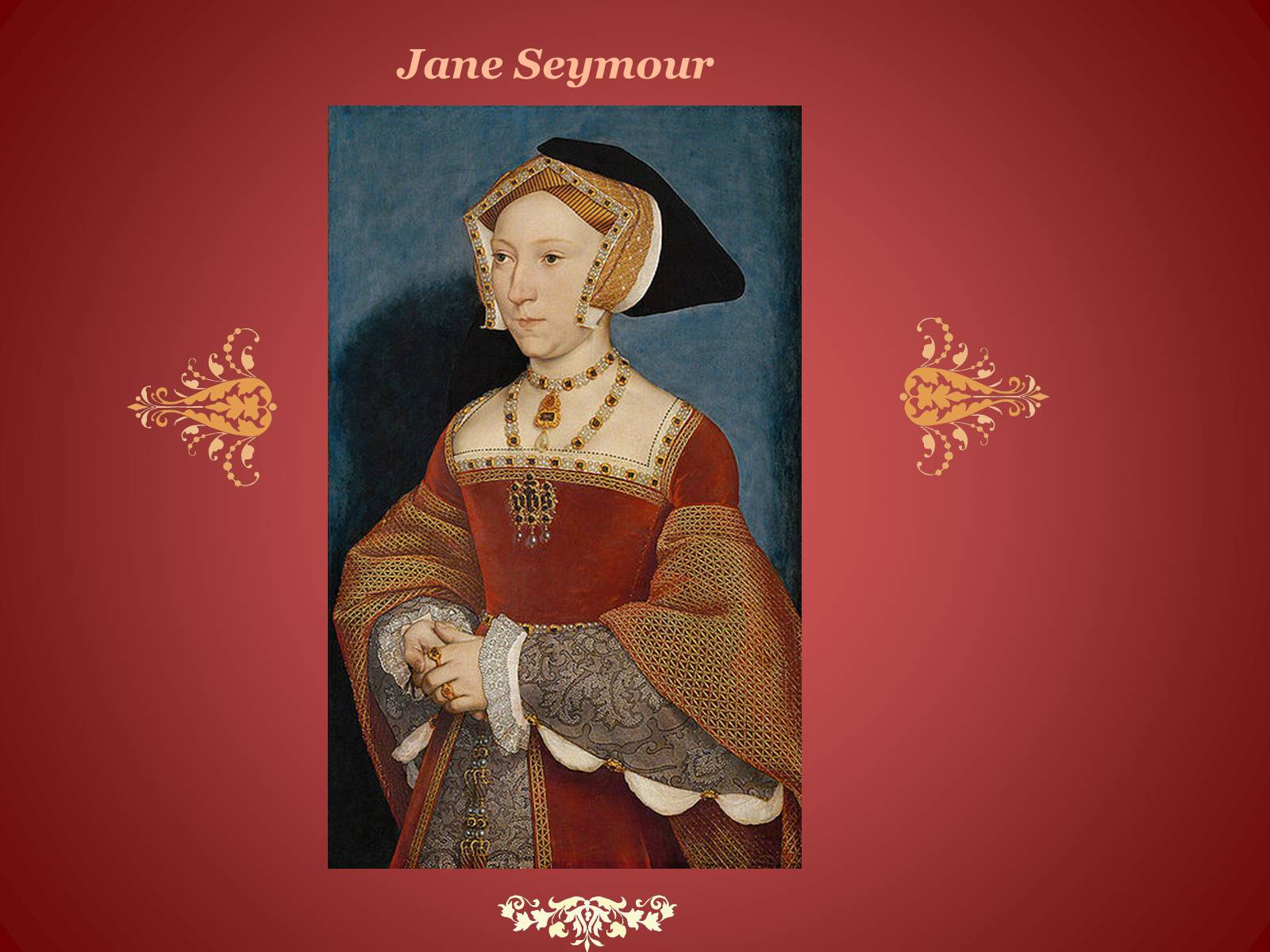
Слайд #6
Catherine Howard
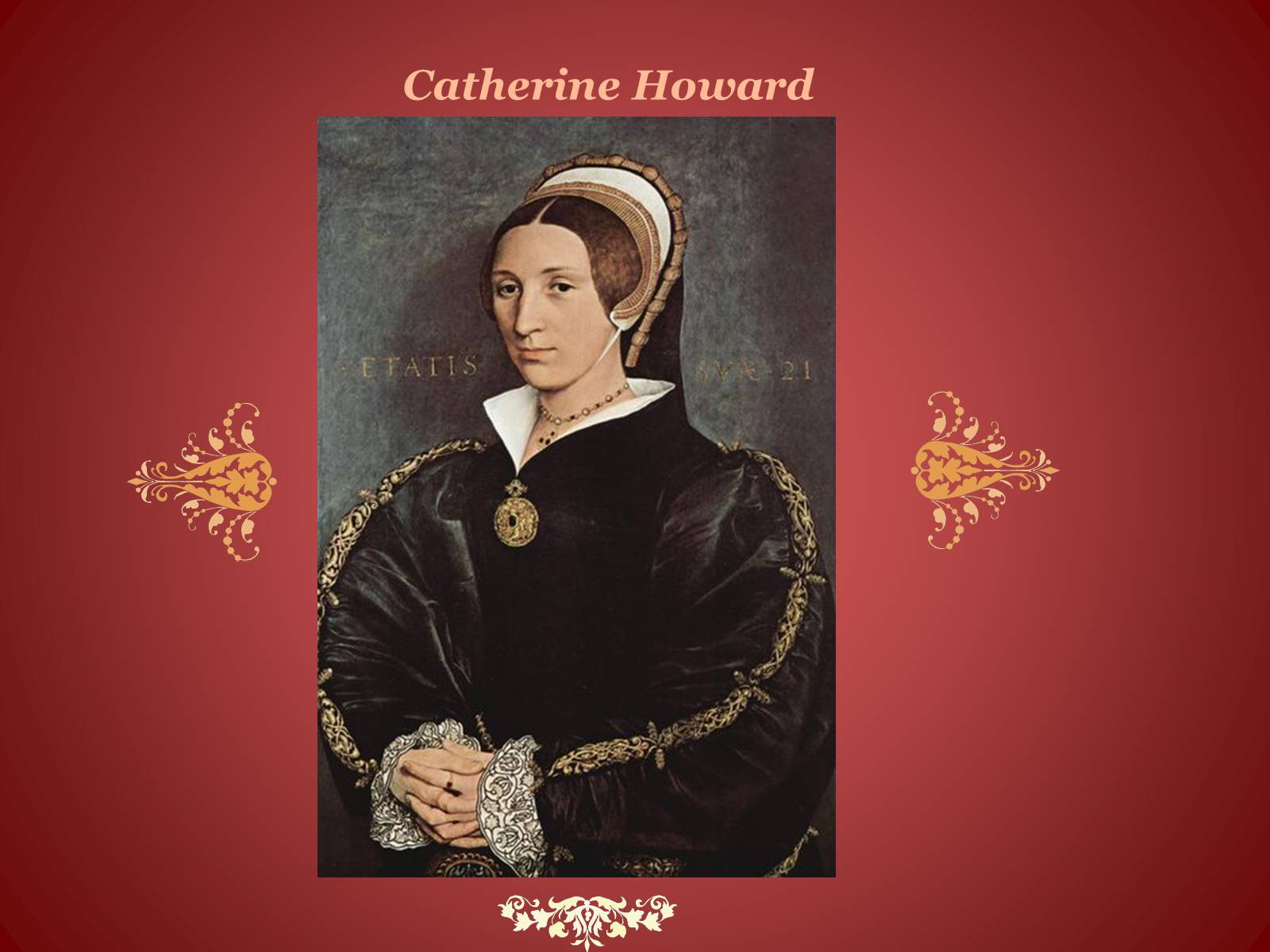
Слайд #7
Anne of Cleves
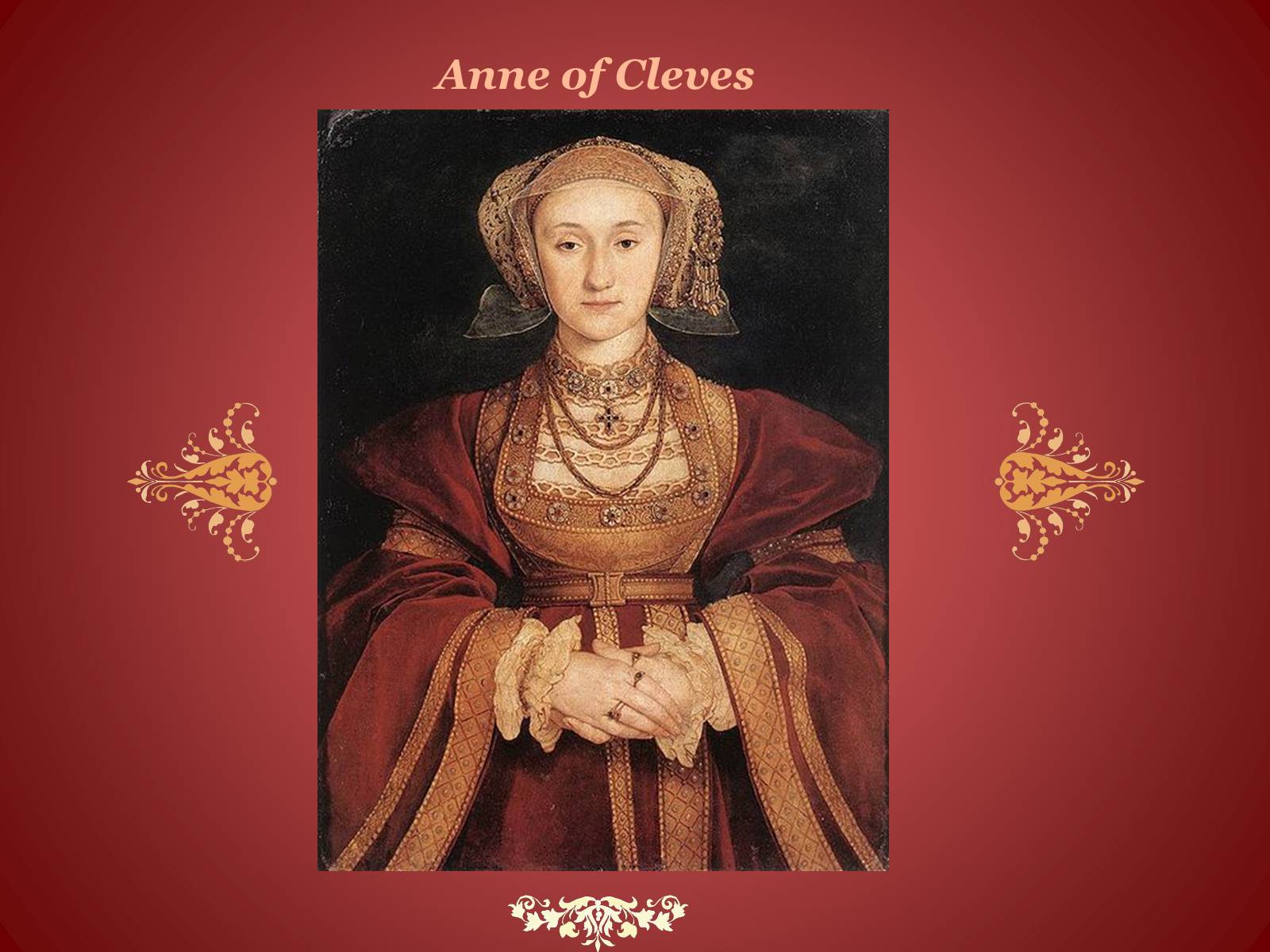
Слайд #8
Catherine Parr
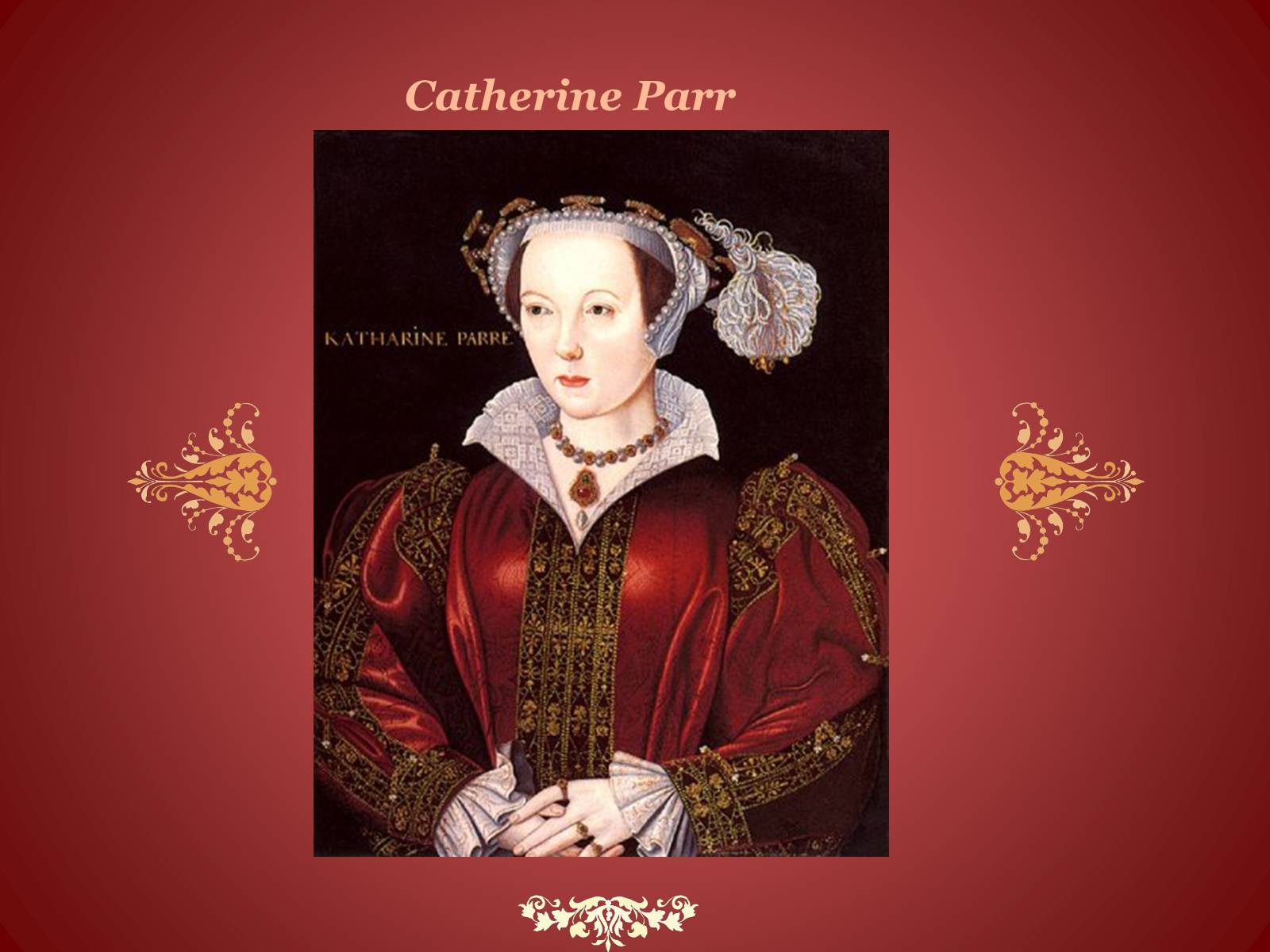
Слайд #9
The Miroir or Glasse of the
Synneful Soul,
a translation from the
French, by Elizabeth,
presented to Catherine
Parr in 1544. The
embroidered binding with
the monogram KP for
"Katherine Parr" is believed
to have been worked by
Elizabeth.
Synneful Soul,
a translation from the
French, by Elizabeth,
presented to Catherine
Parr in 1544. The
embroidered binding with
the monogram KP for
"Katherine Parr" is believed
to have been worked by
Elizabeth.
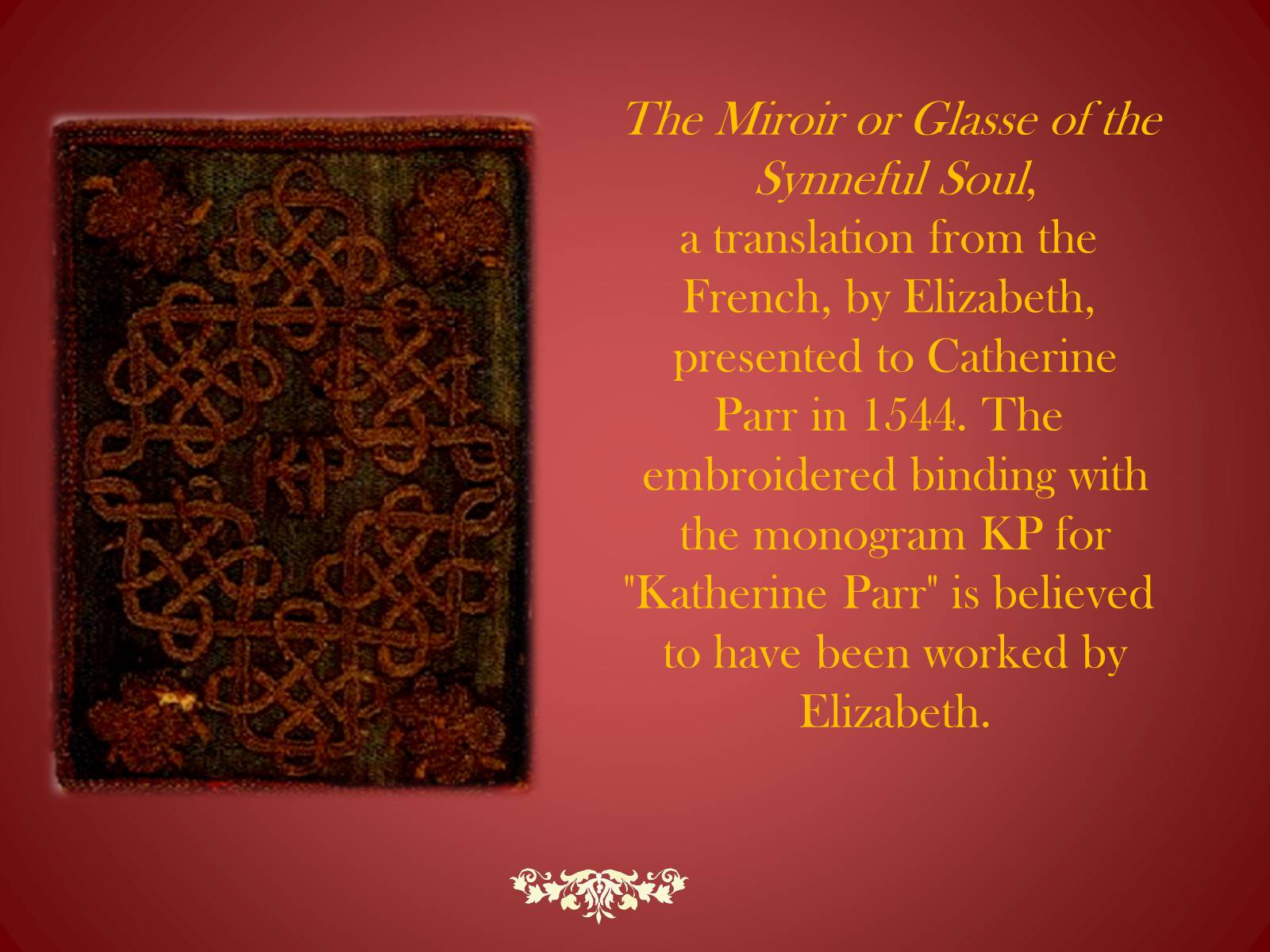
Слайд #10
Edward VI (12 October 1537 – 6 July 1553)
was King of England and Ireland from 28
January 1547 until his death. He was crowned
on 20 February at the age of nine.The son
of Henry VIII and Jane Seymour, Edward was
the third monarch of the Tudor dynasty and
England's first monarch raised as a Protestant.
In February 1553, at age 15, Edward fell ill.
When his sickness was discovered to be
terminal, he and his Council drew up a "Devise
for the Succession", attempting to prevent the
country being returned to Catholicism. Edward
named his cousin Lady Jane Grey as his heir
and excluded his half
sisters, Mary and Elizabeth.
Edward VI
was King of England and Ireland from 28
January 1547 until his death. He was crowned
on 20 February at the age of nine.The son
of Henry VIII and Jane Seymour, Edward was
the third monarch of the Tudor dynasty and
England's first monarch raised as a Protestant.
In February 1553, at age 15, Edward fell ill.
When his sickness was discovered to be
terminal, he and his Council drew up a "Devise
for the Succession", attempting to prevent the
country being returned to Catholicism. Edward
named his cousin Lady Jane Grey as his heir
and excluded his half
sisters, Mary and Elizabeth.
Edward VI
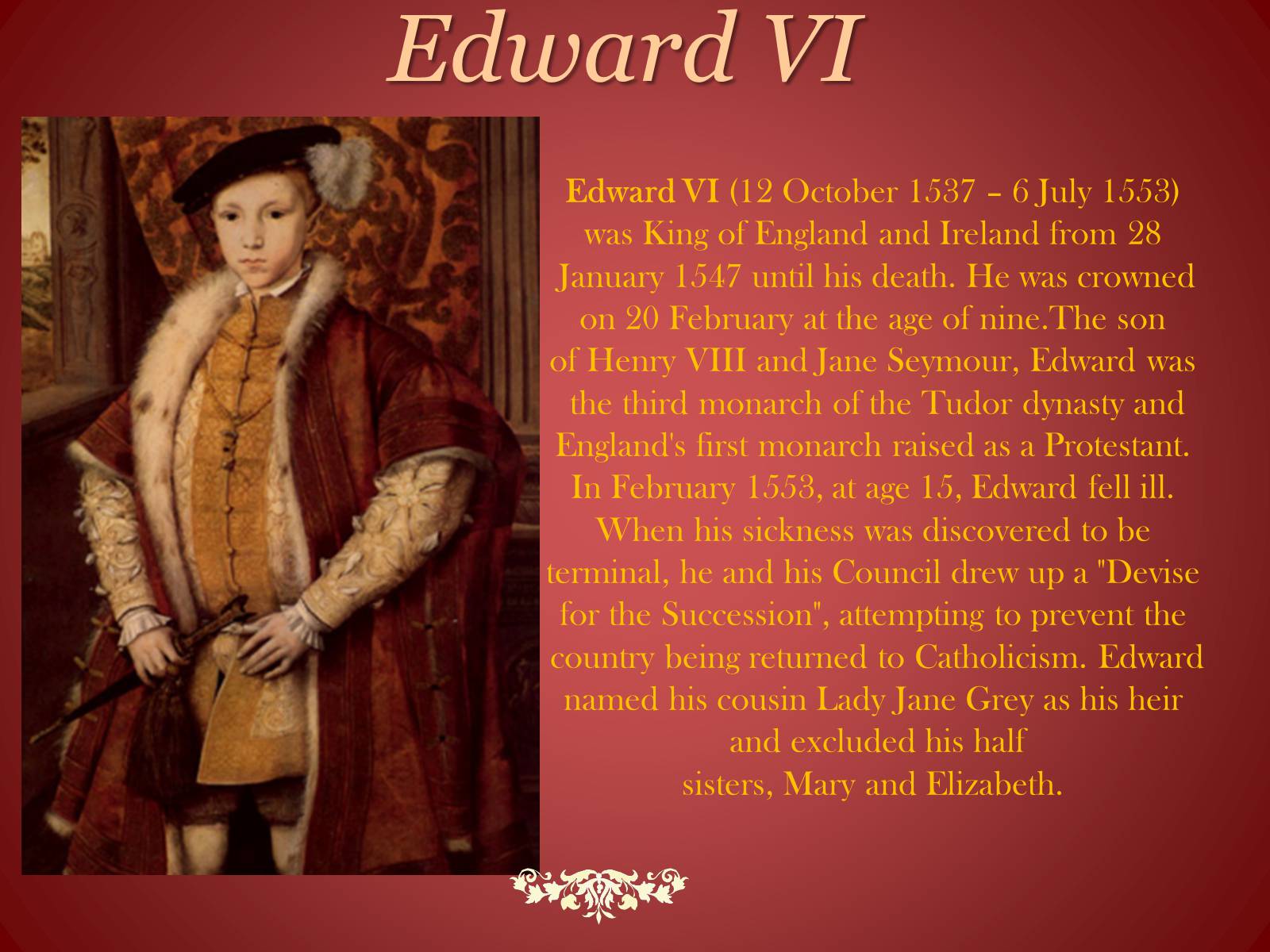
Слайд #11
Mary I (18 February 1516 – 17
November 1558) was Queen of
England and Ireland from July 1553 until
her death. Her brutal persecution
of Protestants caused her opponents to
give her the sobriquet "Bloody Mary".
As the fourth crowned monarch of
the Tudor dynasty, Mary is remembered
for her restoration of Roman Catholicism
after the short-lived Protestant reign of
her half-brother. During her five-year
reign, she had over 280 religious
dissenters burned at the stake in
the Marian persecutions. Her re-
establishment of Roman Catholicism was
reversed after her death in 1558 by her
younger half-sister and
successor, Elizabeth I.
Mary I
November 1558) was Queen of
England and Ireland from July 1553 until
her death. Her brutal persecution
of Protestants caused her opponents to
give her the sobriquet "Bloody Mary".
As the fourth crowned monarch of
the Tudor dynasty, Mary is remembered
for her restoration of Roman Catholicism
after the short-lived Protestant reign of
her half-brother. During her five-year
reign, she had over 280 religious
dissenters burned at the stake in
the Marian persecutions. Her re-
establishment of Roman Catholicism was
reversed after her death in 1558 by her
younger half-sister and
successor, Elizabeth I.
Mary I
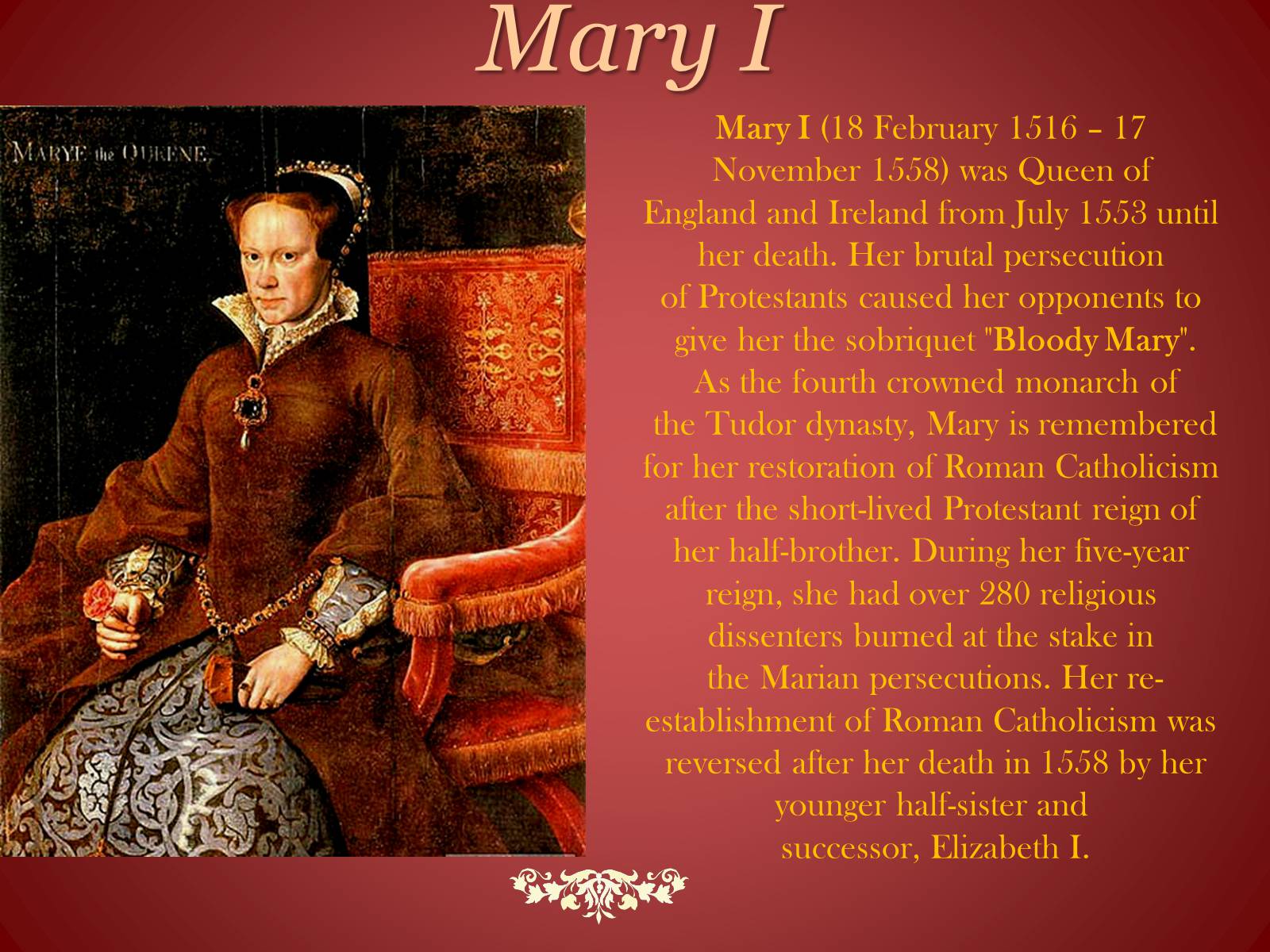
Слайд #12
The prison.
In January and February 1554, Wyatt's
rebellion broke out; it was soon
suppressed.Elizabeth was brought to court, and
interrogated regarding her role, and on 18 March,
she was imprisoned in the Tower of London.
Elizabeth fervently
protested her innocence.Though it is unlikely
that she had plotted with the rebels, some of them
were known to have approached her.On 17 April
1555, Elizabeth was recalled to court to attend the
final stages of Mary's apparent pregnancy. If Mary
and her child died, Elizabeth would become
queen. If, on the other hand, Mary gave birth to a
healthy child, Elizabeth's chances of becoming
queen would recede sharply. When it became clear
that Mary was not pregnant, no one believed any
longer that she could have a child.
In January and February 1554, Wyatt's
rebellion broke out; it was soon
suppressed.Elizabeth was brought to court, and
interrogated regarding her role, and on 18 March,
she was imprisoned in the Tower of London.
Elizabeth fervently
protested her innocence.Though it is unlikely
that she had plotted with the rebels, some of them
were known to have approached her.On 17 April
1555, Elizabeth was recalled to court to attend the
final stages of Mary's apparent pregnancy. If Mary
and her child died, Elizabeth would become
queen. If, on the other hand, Mary gave birth to a
healthy child, Elizabeth's chances of becoming
queen would recede sharply. When it became clear
that Mary was not pregnant, no one believed any
longer that she could have a child.
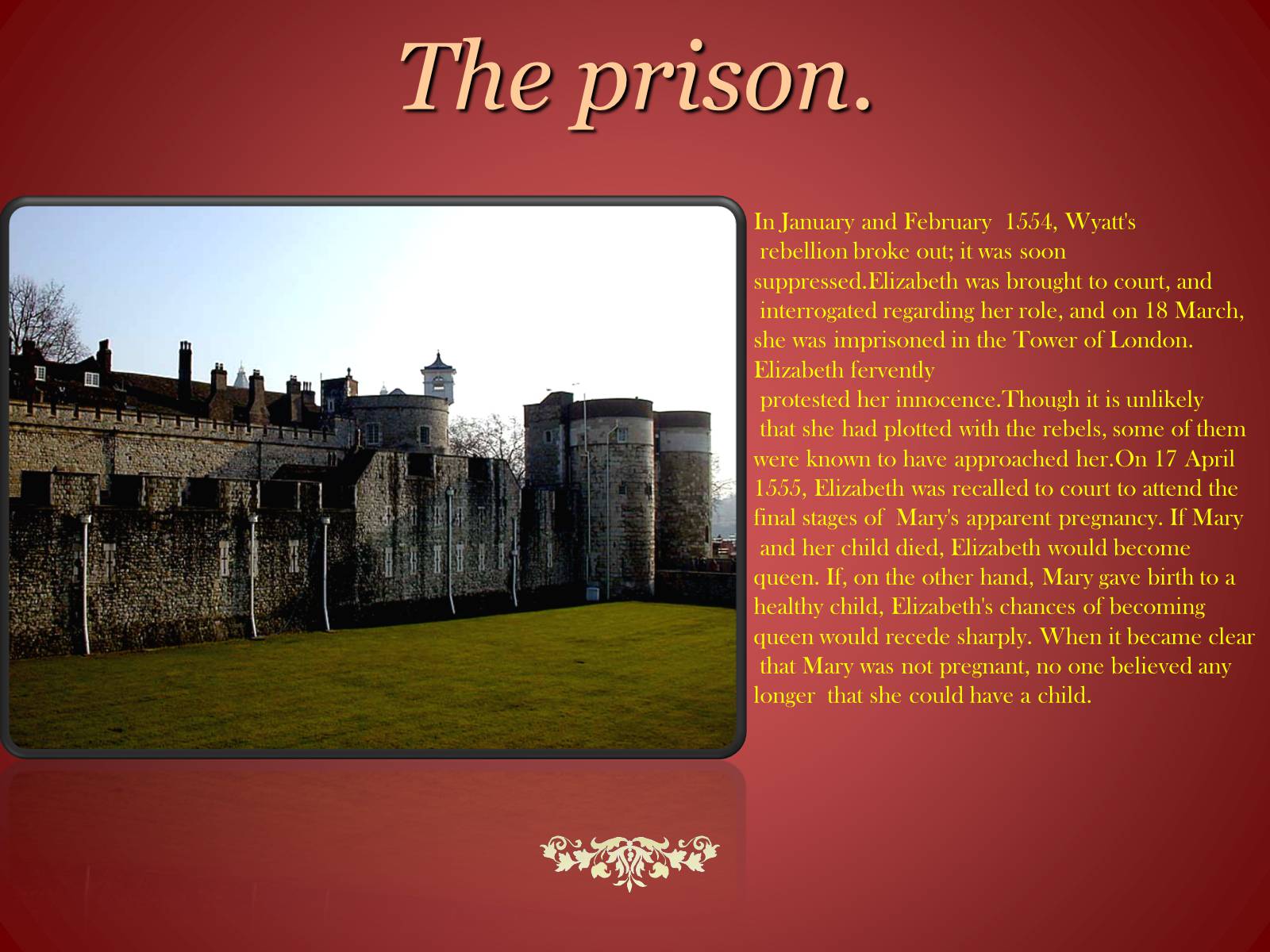
Слайд #13
The prison.
In January and February 1554, Wyatt's
rebellion broke out; it was soon
suppressed.Elizabeth was brought to court, and
interrogated regarding her role, and on 18 March,
she was imprisoned in the Tower of London.
Elizabeth fervently
protested her innocence.Though it is unlikely
that she had plotted with the rebels, some of them
were known to have approached her.On 17 April
1555, Elizabeth was recalled to court to attend the
final stages of Mary's apparent pregnancy. If Mary
and her child died, Elizabeth would become
queen. If, on the other hand, Mary gave birth to a
healthy child, Elizabeth's chances of becoming
queen would recede sharply. When it became clear
that Mary was not pregnant, no one believed any
longer that she could have a child.
In January and February 1554, Wyatt's
rebellion broke out; it was soon
suppressed.Elizabeth was brought to court, and
interrogated regarding her role, and on 18 March,
she was imprisoned in the Tower of London.
Elizabeth fervently
protested her innocence.Though it is unlikely
that she had plotted with the rebels, some of them
were known to have approached her.On 17 April
1555, Elizabeth was recalled to court to attend the
final stages of Mary's apparent pregnancy. If Mary
and her child died, Elizabeth would become
queen. If, on the other hand, Mary gave birth to a
healthy child, Elizabeth's chances of becoming
queen would recede sharply. When it became clear
that Mary was not pregnant, no one believed any
longer that she could have a child.
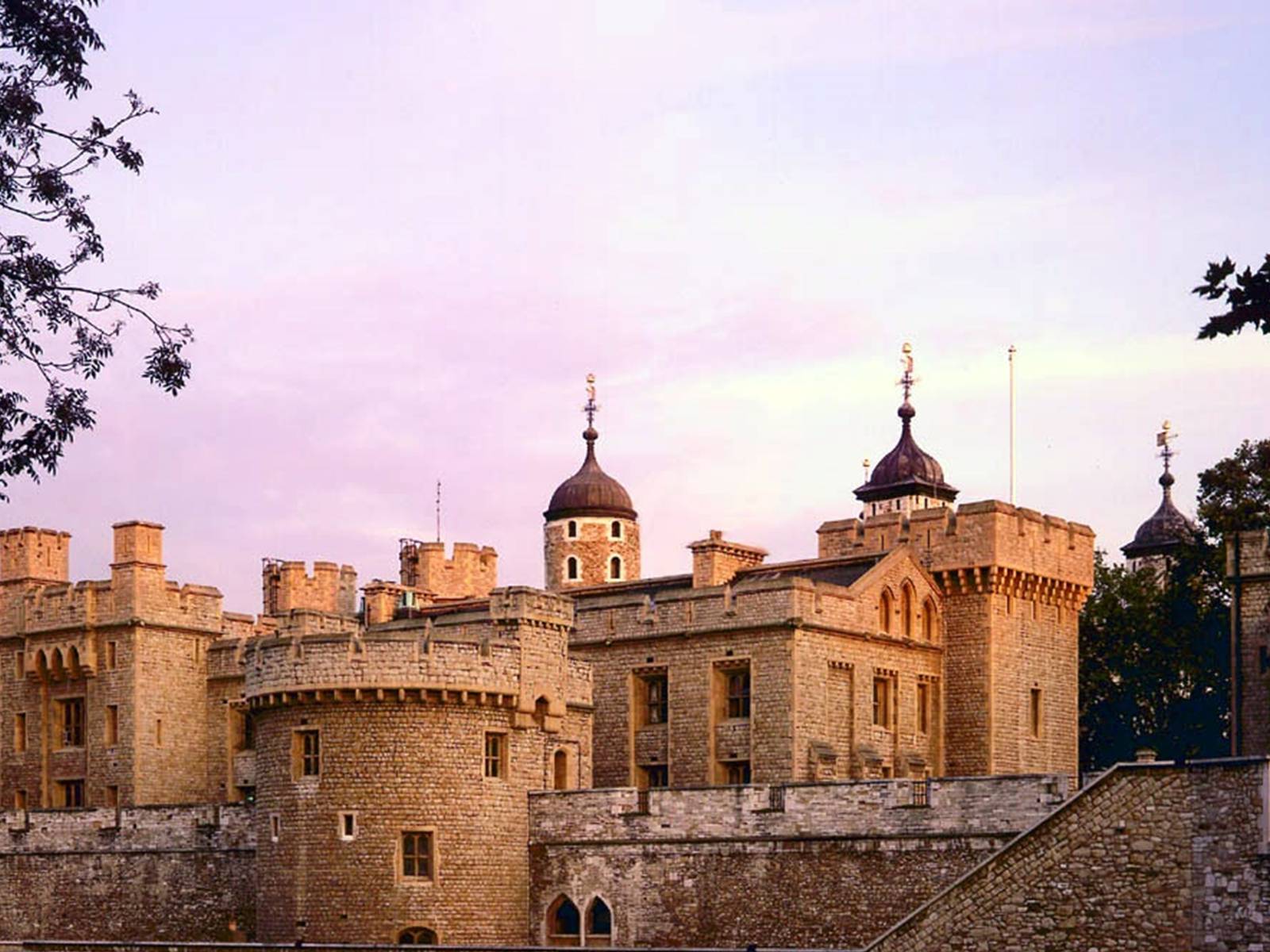
Слайд #14
Elizabeth I in her
coronation robes,
patterned with Tudor
roses and trimmed
with ermine.
coronation robes,
patterned with Tudor
roses and trimmed
with ermine.
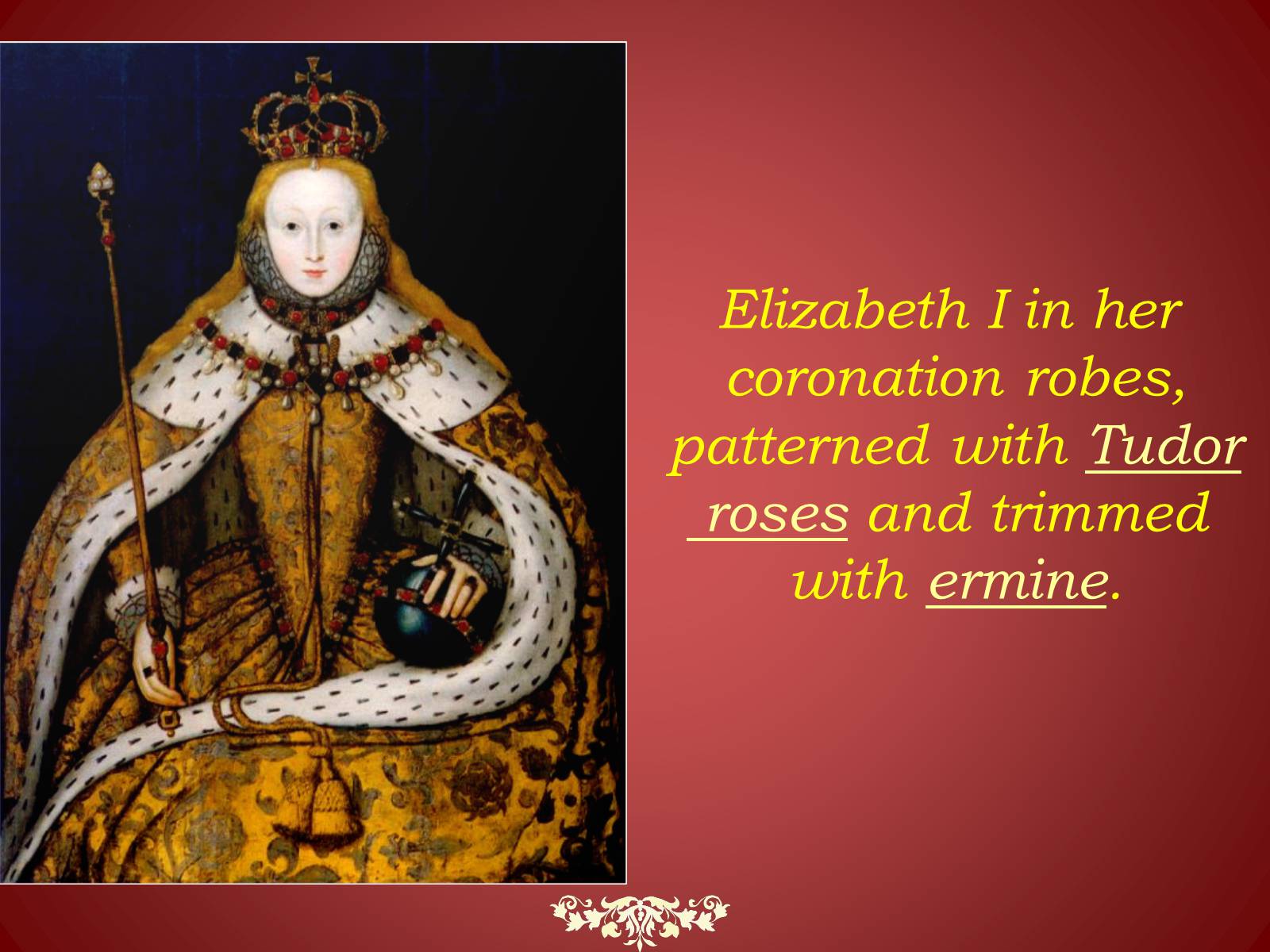
Слайд #15
William Cecil, 1st Baron
Burghley was an English
statesman, the chief advisor
of Queen Elizabeth I for most of her
reign, twice Secretary of
State (1550–1553 and 1558–1572)
and Lord High Treasurer from 1572.
He was the founder of the Cecil
dynasty which has produced many
politicians including two Prime
Ministers.
William Cecil
Burghley was an English
statesman, the chief advisor
of Queen Elizabeth I for most of her
reign, twice Secretary of
State (1550–1553 and 1558–1572)
and Lord High Treasurer from 1572.
He was the founder of the Cecil
dynasty which has produced many
politicians including two Prime
Ministers.
William Cecil
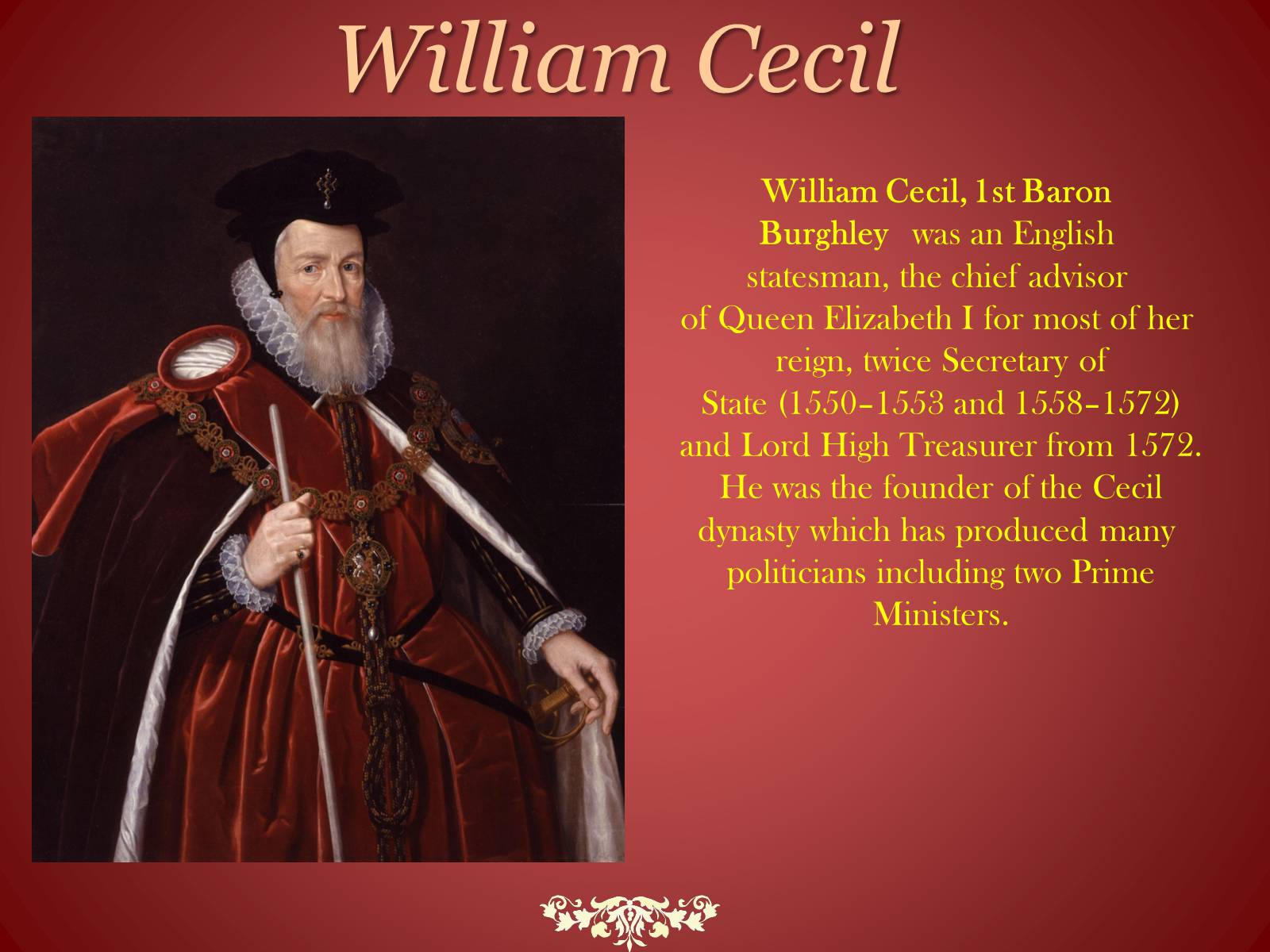
Слайд #16
The Lady Elizabeth in about 1546, by
an unknown artist.
an unknown artist.
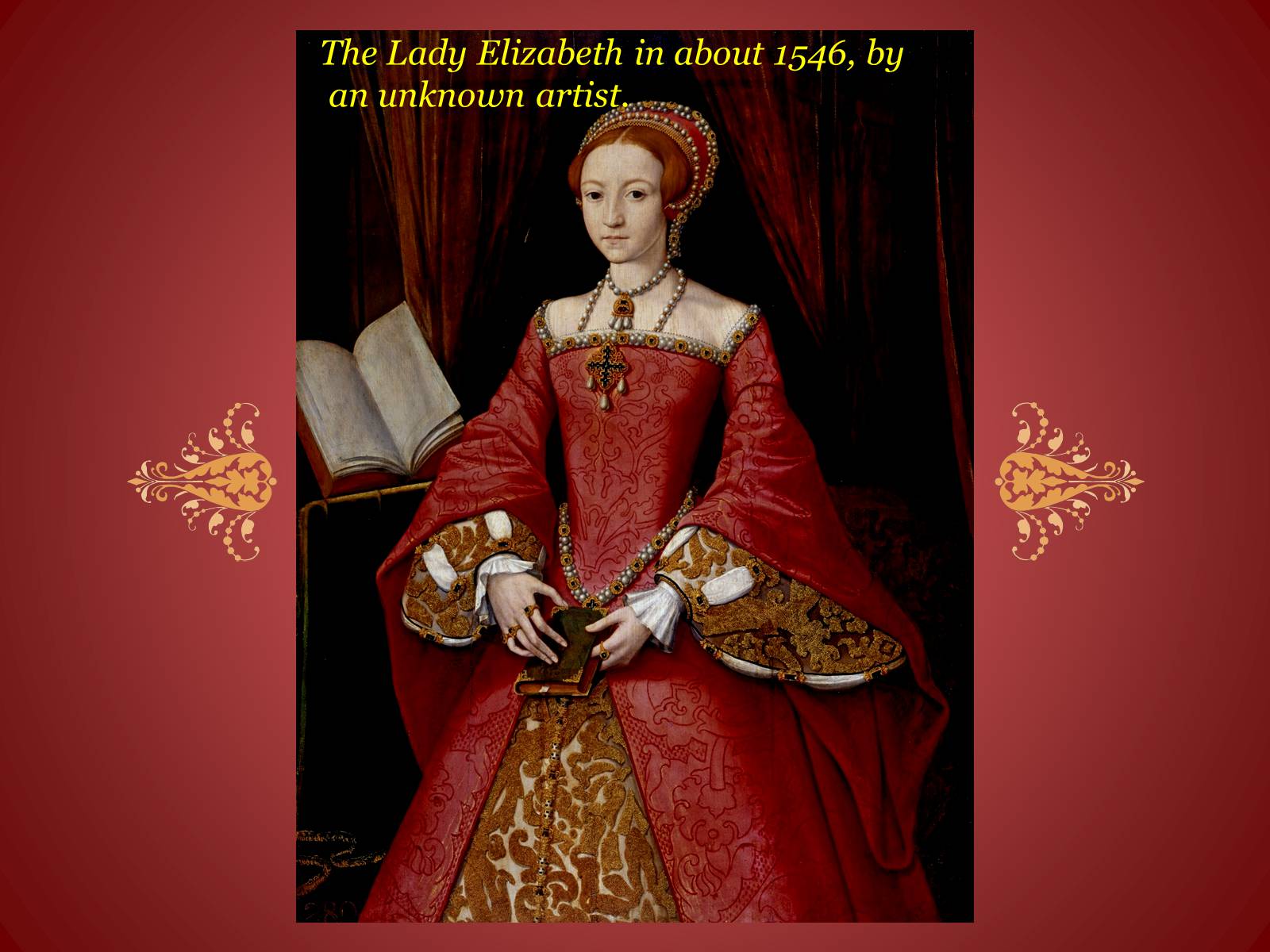
Слайд #17
Robert Dudley, 1st Earl of
Leicester was an
English nobleman and
the favourite and close friend
of Elizabeth I from her first
year on the throne until his
death. She giving him reason
to hope, he was a suitor for
the Queen's hand for many
years. In 1564 Dudley
became Earl of Leicester and
from 1563 one of the greatest
landowners in North
Wales and the EnglishWest
Midlands by royal grants.
Robert Dudley
Leicester was an
English nobleman and
the favourite and close friend
of Elizabeth I from her first
year on the throne until his
death. She giving him reason
to hope, he was a suitor for
the Queen's hand for many
years. In 1564 Dudley
became Earl of Leicester and
from 1563 one of the greatest
landowners in North
Wales and the EnglishWest
Midlands by royal grants.
Robert Dudley
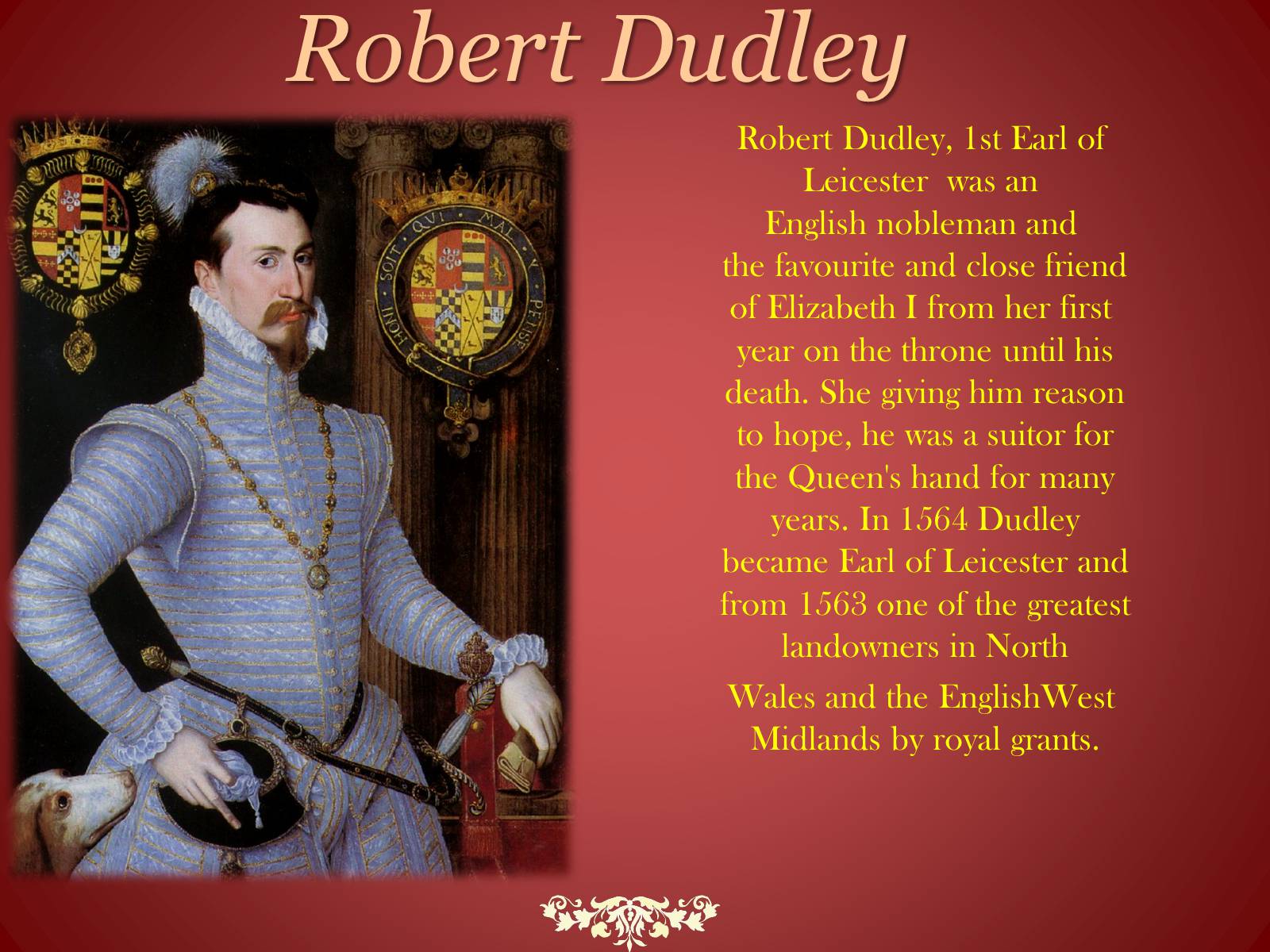
Слайд #18
Elizabeth liked luxury. She had 300 dresses, a lot of diamonds, wigs, cosmetics. When she stood she seemed to be the Sun, or the Star which dazzled its magnificence…
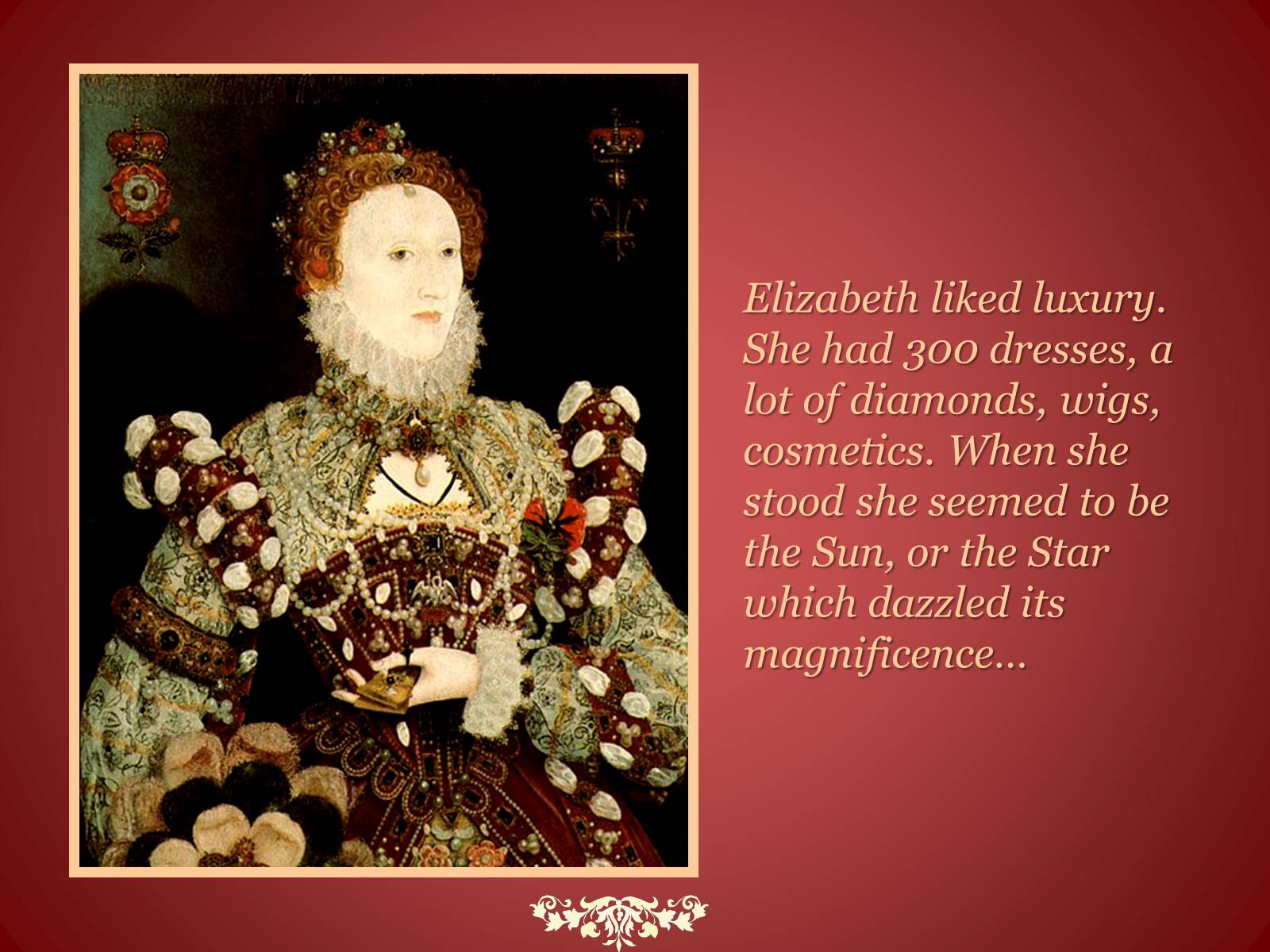
Слайд #19
Sir Francis Drake, Vice
Admiral (1540 – 27 January 1596) was
an English sea
captain, privateer, navigator, slaver,
andpolitician of the Elizabethan
era. Elizabeth I of Englandawarded
Drake a knighthood in 1581. He was
second-in-command of the English
fleet against the Spanish Armada in
1588. He also carried out the
second circumnavigation of the world,
from 1577 to 1580. He died
of dysentery in January 1596 after
unsuccessfully attacking San Juan,
Puerto Rico.
His exploits were legendary, making
him a hero to the English but
a pirate to the Spaniards to whom he
was known as El Draque.
Sir Francis Drake
Admiral (1540 – 27 January 1596) was
an English sea
captain, privateer, navigator, slaver,
andpolitician of the Elizabethan
era. Elizabeth I of Englandawarded
Drake a knighthood in 1581. He was
second-in-command of the English
fleet against the Spanish Armada in
1588. He also carried out the
second circumnavigation of the world,
from 1577 to 1580. He died
of dysentery in January 1596 after
unsuccessfully attacking San Juan,
Puerto Rico.
His exploits were legendary, making
him a hero to the English but
a pirate to the Spaniards to whom he
was known as El Draque.
Sir Francis Drake
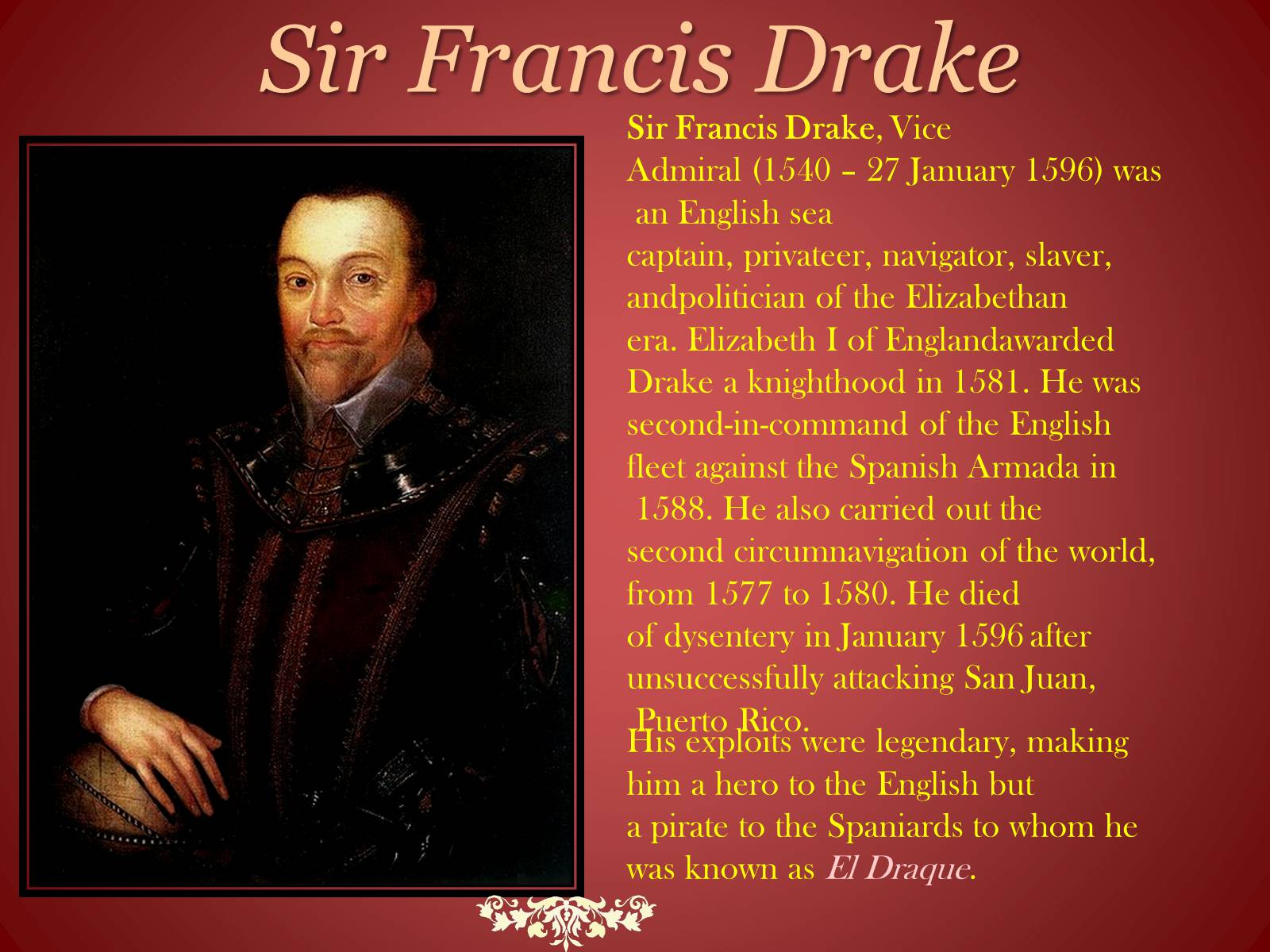
Слайд #20
Sir Walter Raleigh
Sir Walter Raleigh was an English
aristocrat, writer, poet, soldier, courtier,
spy, and explorer. He is also well
known for popularising tobacco and
potato in England.
Sir Walter Raleigh was an English
aristocrat, writer, poet, soldier, courtier,
spy, and explorer. He is also well
known for popularising tobacco and
potato in England.
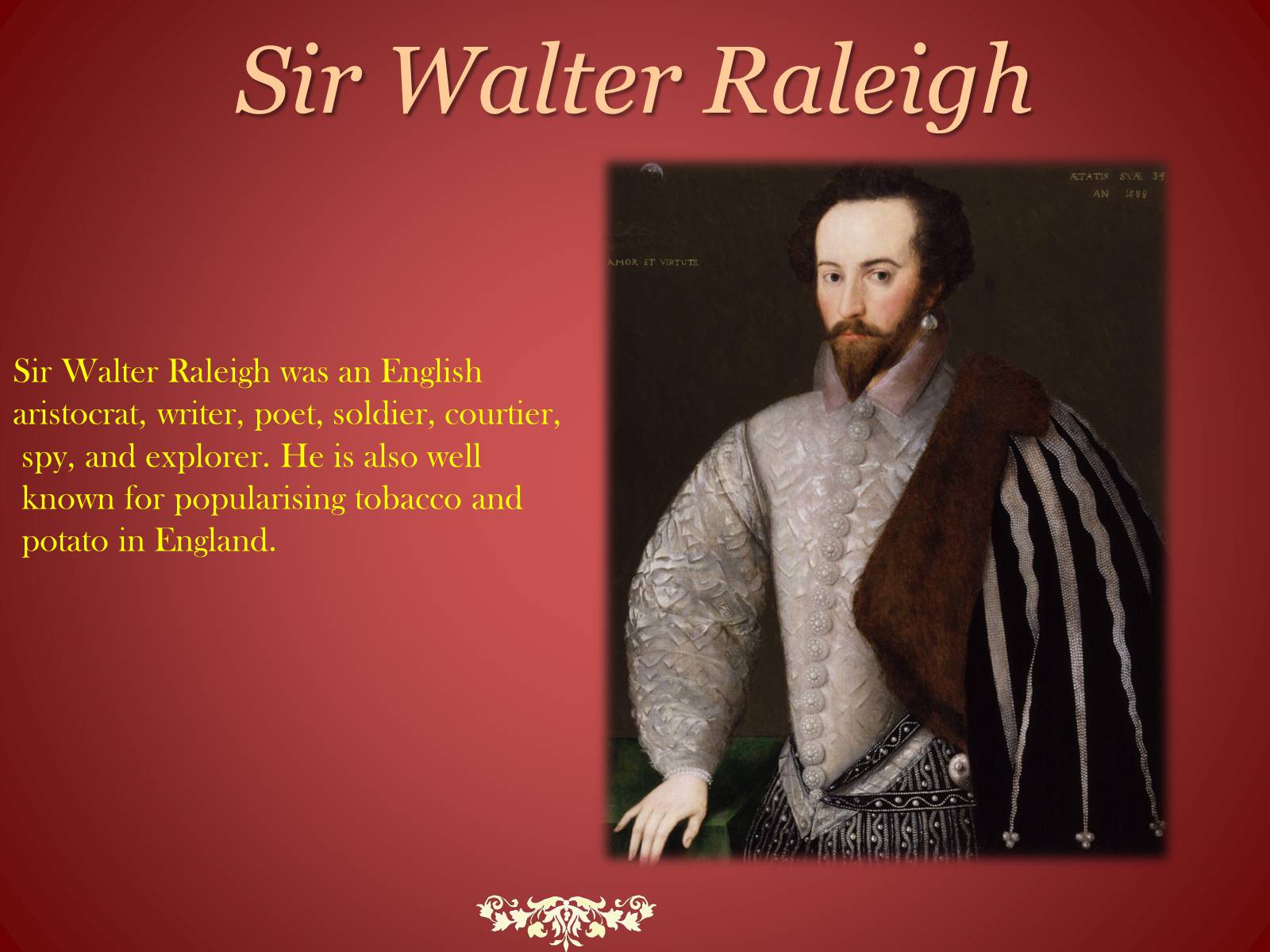
Слайд #21
Two rivals.
Mary Stuart
Elizabeth Tudor
Mary Stuart
Elizabeth Tudor
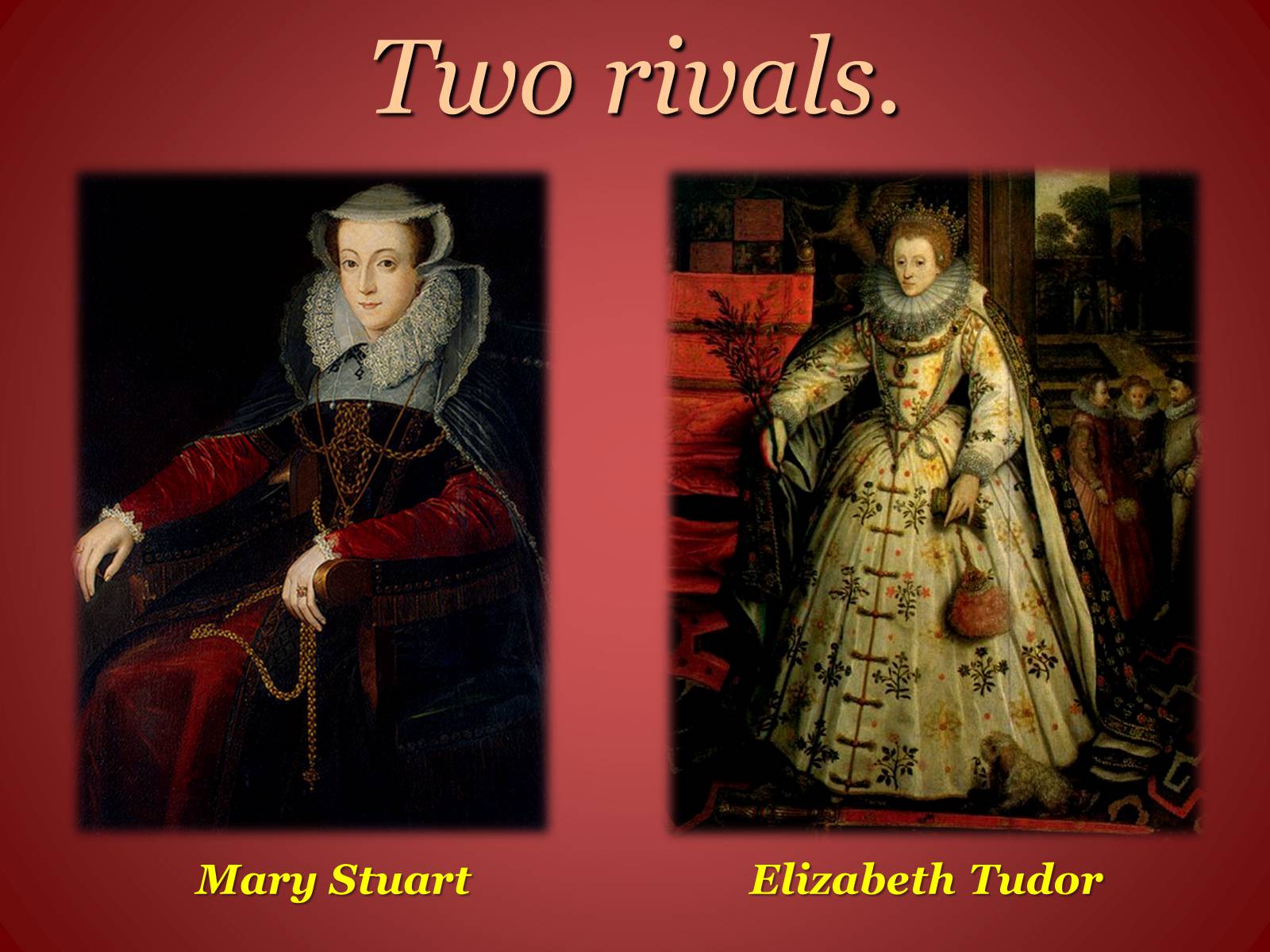
Слайд #22
Mary Stuart`s execution in 1587
Mary was not beheaded with a single strike. The first blow missed her neck and struck the back of her head. The second blow severed the neck, except for a small bit of sinew, which the executioner cut through using the axe. Afterward, he held her head aloft . At that moment, the auburn tresses in his hand turned out to be a wig and the head fell to the ground, revealing that Mary had very short, grey hair. A small dog owned by the queen, a Skye terrier, is said to have been hiding among her skirts, unseen by the spectators. Following the beheading, it refused to be parted from its owner's body and was covered in her blood, until it was forcibly taken away and washed.
Mary's death mask in Westminster Abbey.
Mary was not beheaded with a single strike. The first blow missed her neck and struck the back of her head. The second blow severed the neck, except for a small bit of sinew, which the executioner cut through using the axe. Afterward, he held her head aloft . At that moment, the auburn tresses in his hand turned out to be a wig and the head fell to the ground, revealing that Mary had very short, grey hair. A small dog owned by the queen, a Skye terrier, is said to have been hiding among her skirts, unseen by the spectators. Following the beheading, it refused to be parted from its owner's body and was covered in her blood, until it was forcibly taken away and washed.
Mary's death mask in Westminster Abbey.
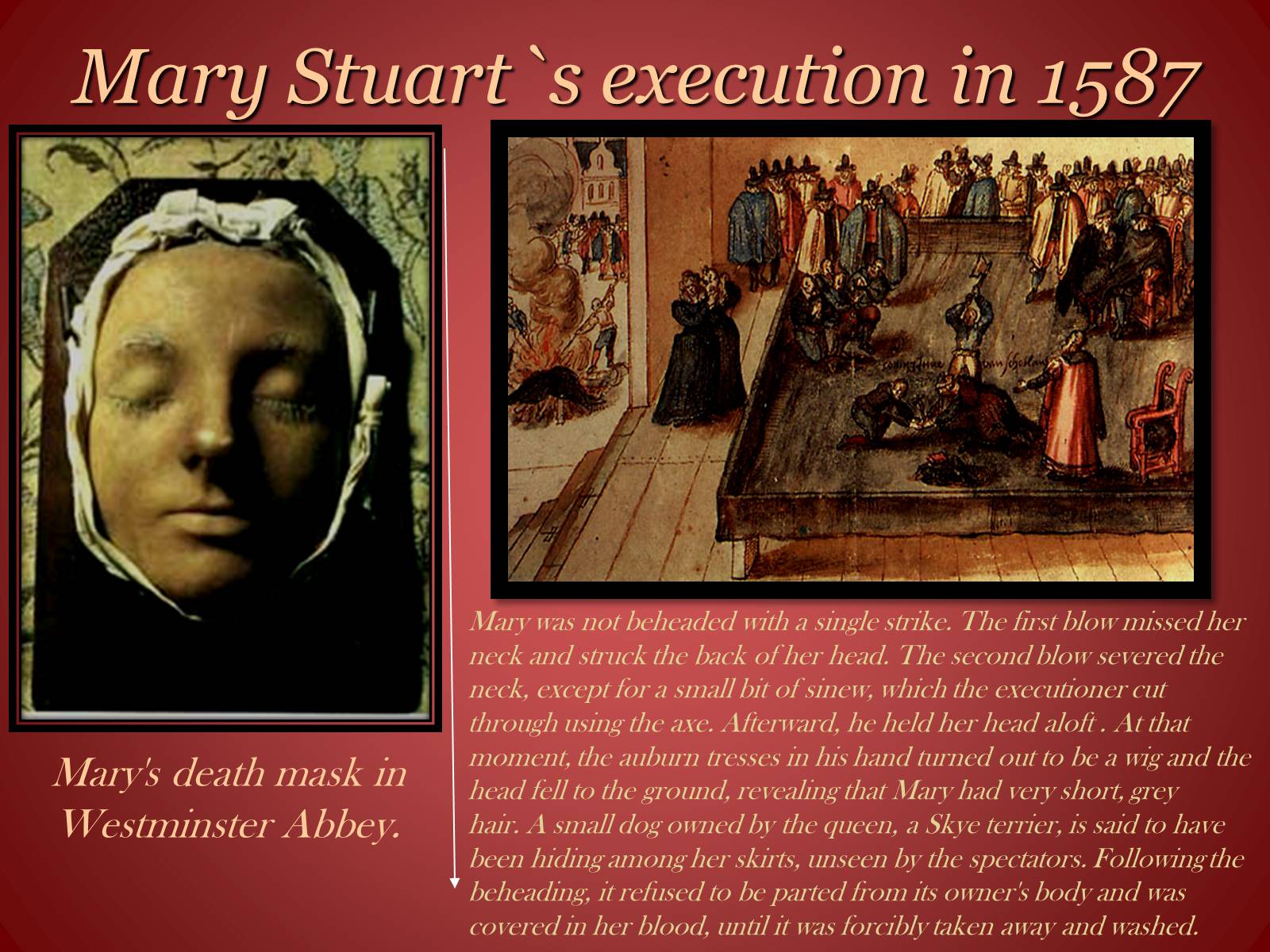
Слайд #23
Spanish Armada.
On 12 July 1588, the Spanish Armada, a great fleet of ships, set sail for the channel, planning to ferry a Spanish invasion force under the Duke of Parma to the coast of southeast England from the Netherlands. A combination of miscalculation, misfortune, and an attack of English fire ships on 29 July off Gravelines which dispersed the Spanish ships to the northeast defeated the Armada.The Armada straggled home to Spain in shattered remnants, after disastrous losses on the coast of Ireland.
On 12 July 1588, the Spanish Armada, a great fleet of ships, set sail for the channel, planning to ferry a Spanish invasion force under the Duke of Parma to the coast of southeast England from the Netherlands. A combination of miscalculation, misfortune, and an attack of English fire ships on 29 July off Gravelines which dispersed the Spanish ships to the northeast defeated the Armada.The Armada straggled home to Spain in shattered remnants, after disastrous losses on the coast of Ireland.
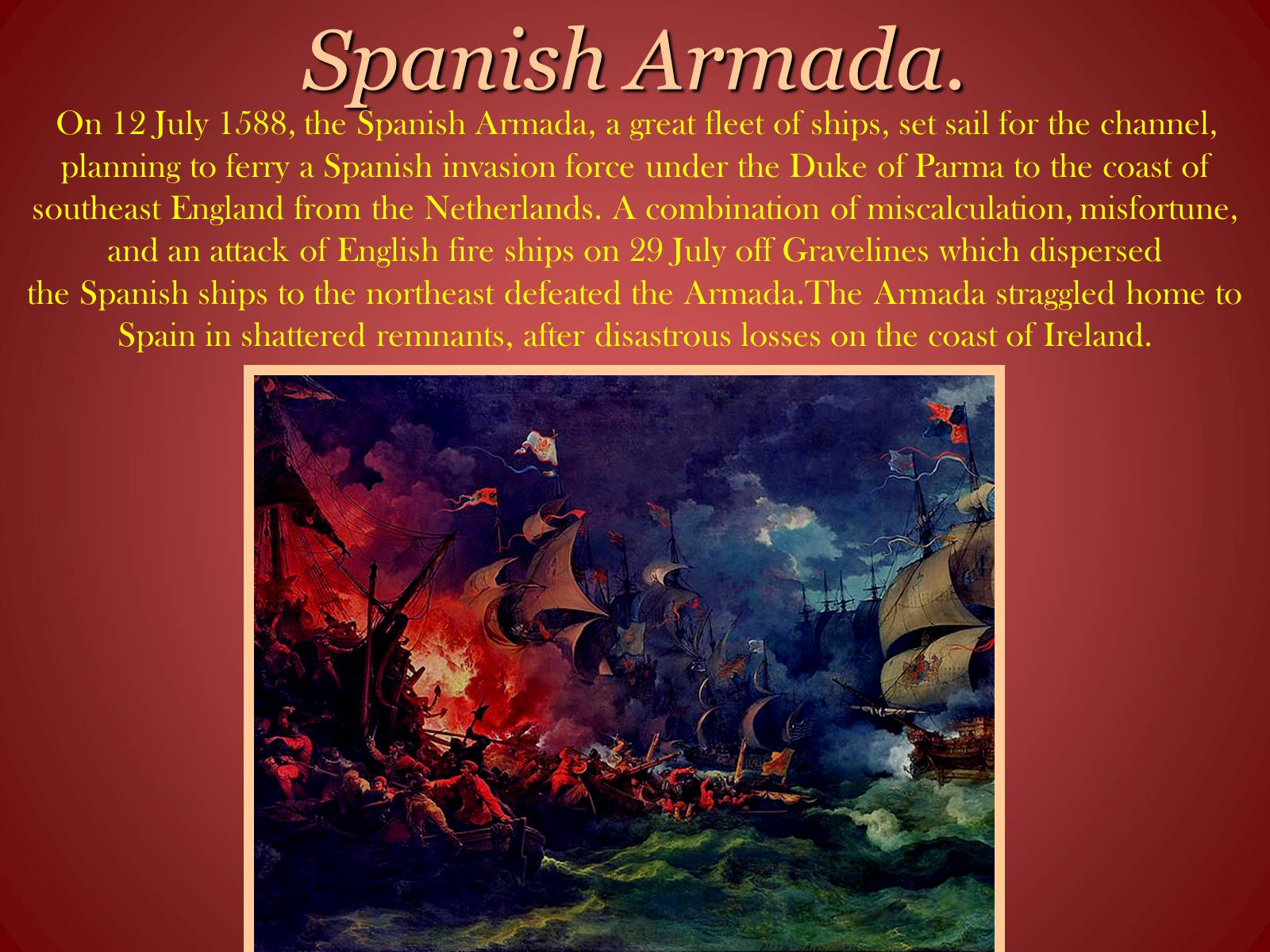
Слайд #24
Robert Devereux, 2nd Earl of Essex was
an English nobleman and a favourite of Elizabeth
I. Politically ambitious, and a committed general,
he was placed under house arrest following a
poor campaign in Ireland during the Nine
Years' War in 1599. In 1601 he led an
abortive coup d'étatagainst the government
and was executed for treason.
The last love.
an English nobleman and a favourite of Elizabeth
I. Politically ambitious, and a committed general,
he was placed under house arrest following a
poor campaign in Ireland during the Nine
Years' War in 1599. In 1601 he led an
abortive coup d'étatagainst the government
and was executed for treason.
The last love.

Слайд #25
Laetitia Knollys
Also known as Lettice
Devereux or Lettice
Dudley), Countess of
Essex and Countess of Leicester (8
November 1543 – 25 December
1634), was an English noblewoman
and mother to the courtiers Robert
Devereux, 2nd Earl of Essex. A
grandniece of Anne Boleyn and close
to Princess Elizabeth since childhood,
Lettice Knollys was introduced early
into court life.
Also known as Lettice
Devereux or Lettice
Dudley), Countess of
Essex and Countess of Leicester (8
November 1543 – 25 December
1634), was an English noblewoman
and mother to the courtiers Robert
Devereux, 2nd Earl of Essex. A
grandniece of Anne Boleyn and close
to Princess Elizabeth since childhood,
Lettice Knollys was introduced early
into court life.
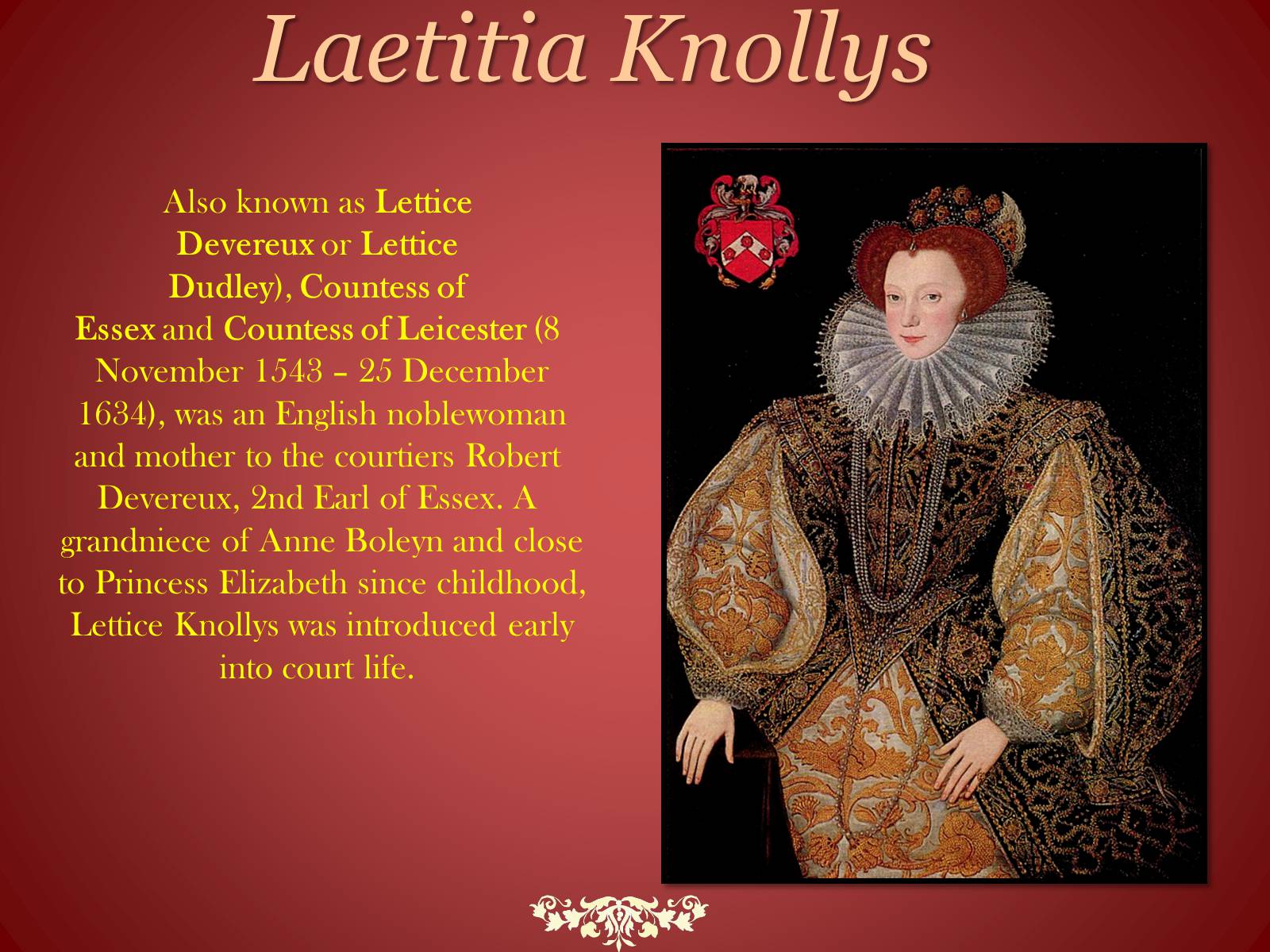
Слайд #26
The last cloister.
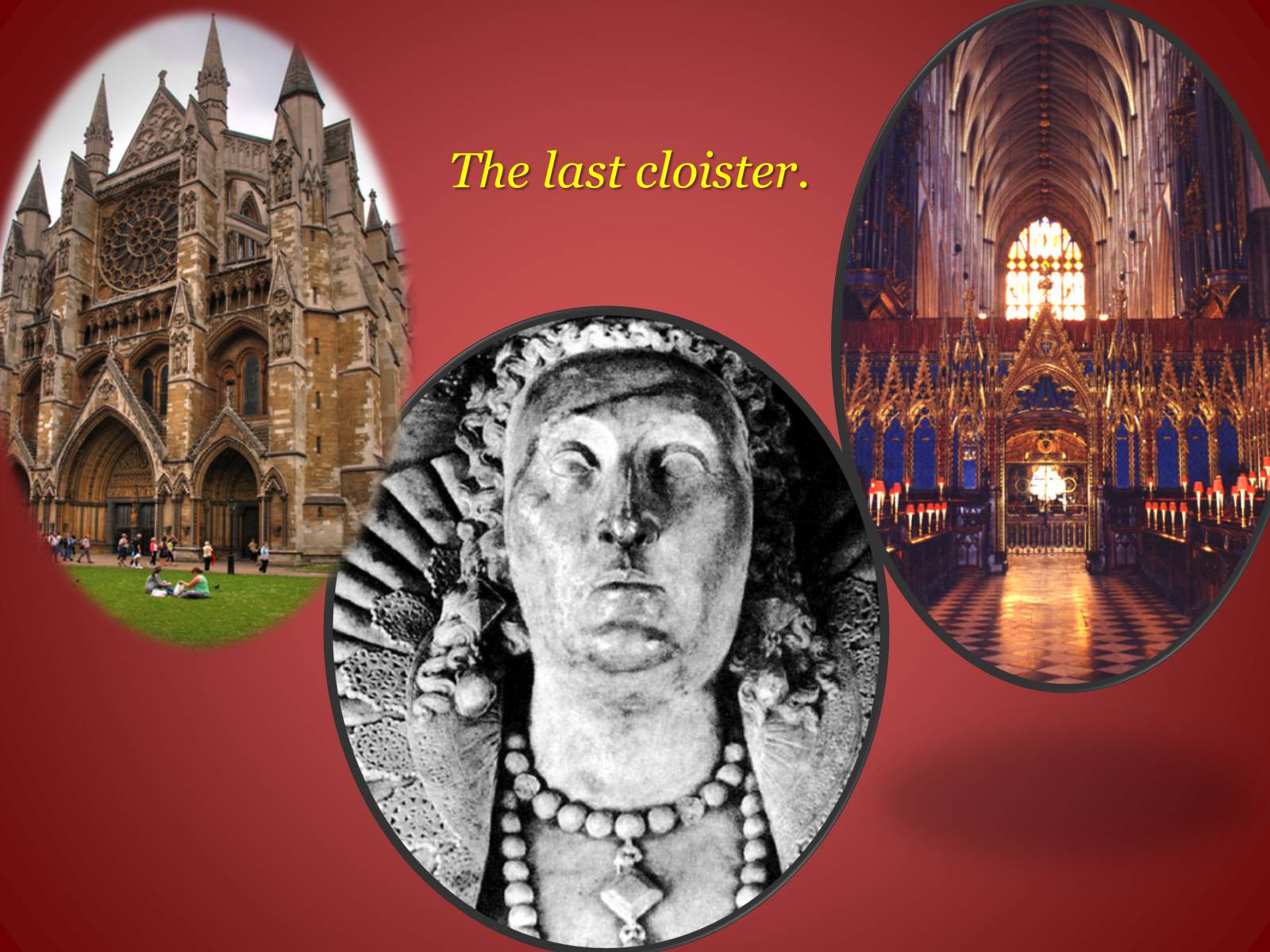
Слайд #27
The Latin translates:
"Partners both in
throne and grave, here rest we two
sisters, Elizabeth and Mary
,in the hope of one resurrection."
"Partners both in
throne and grave, here rest we two
sisters, Elizabeth and Mary
,in the hope of one resurrection."
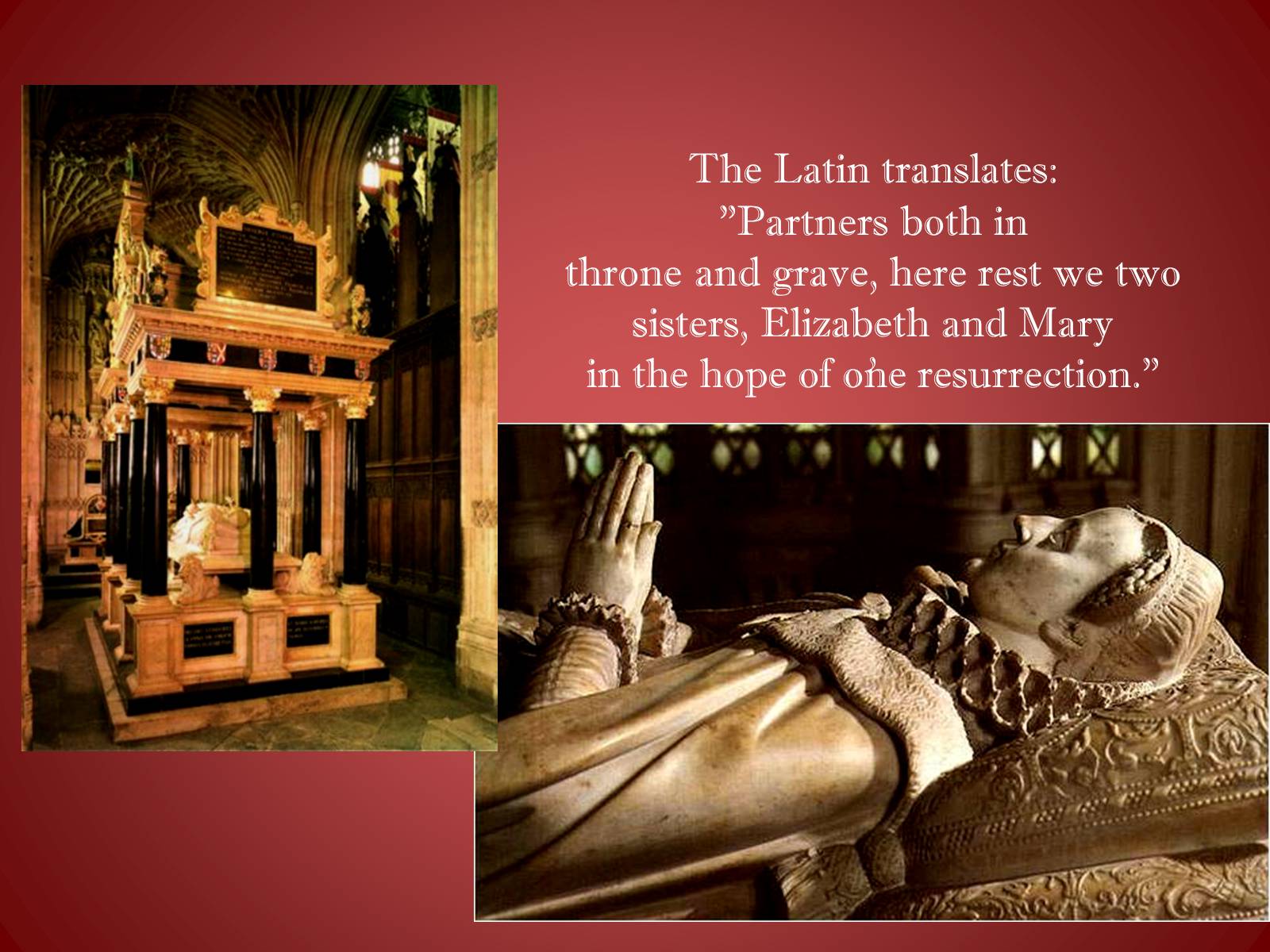
Слайд #28
Gallery

Слайд #29
Gallery
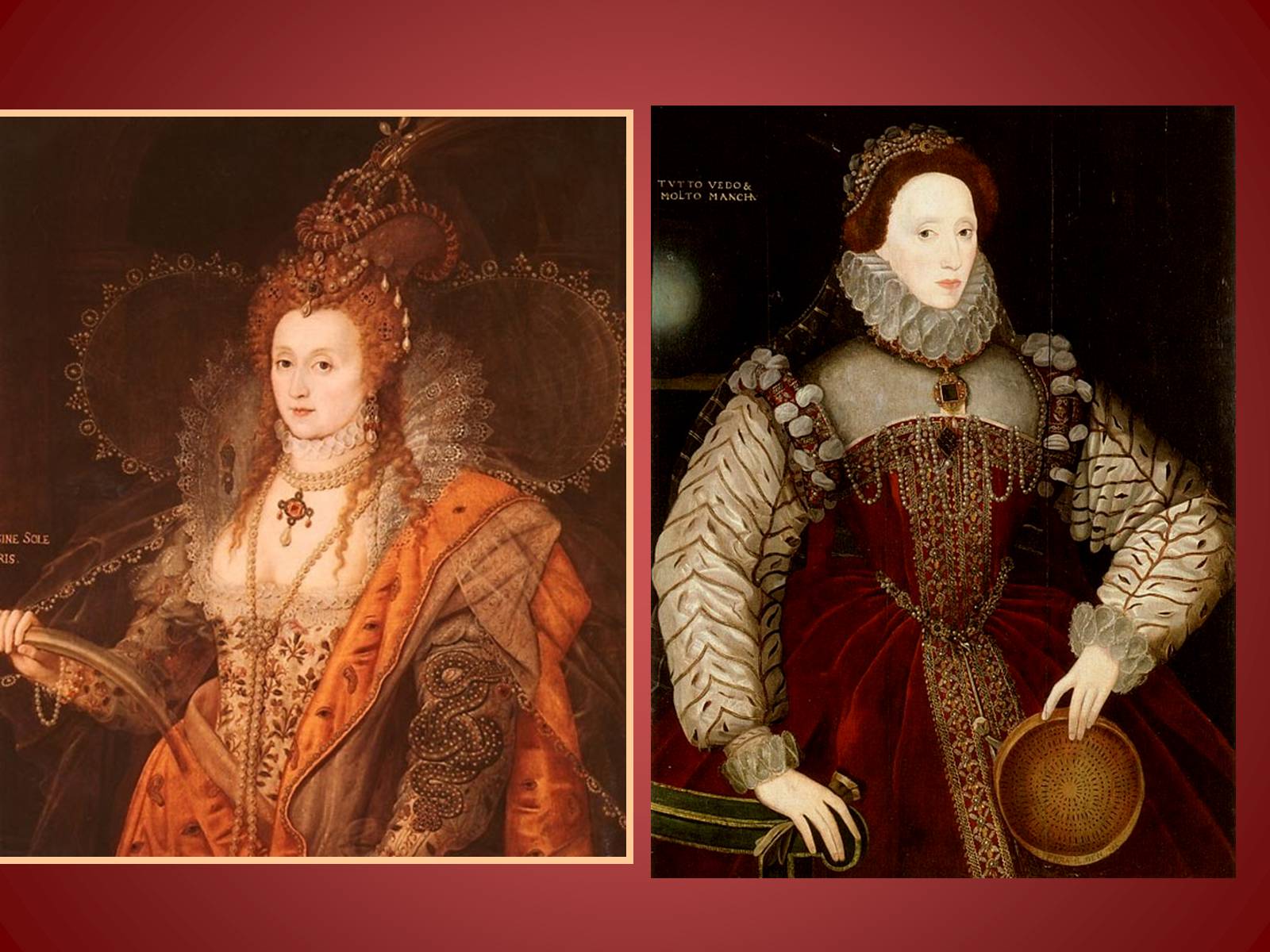
Слайд #30
Gallery
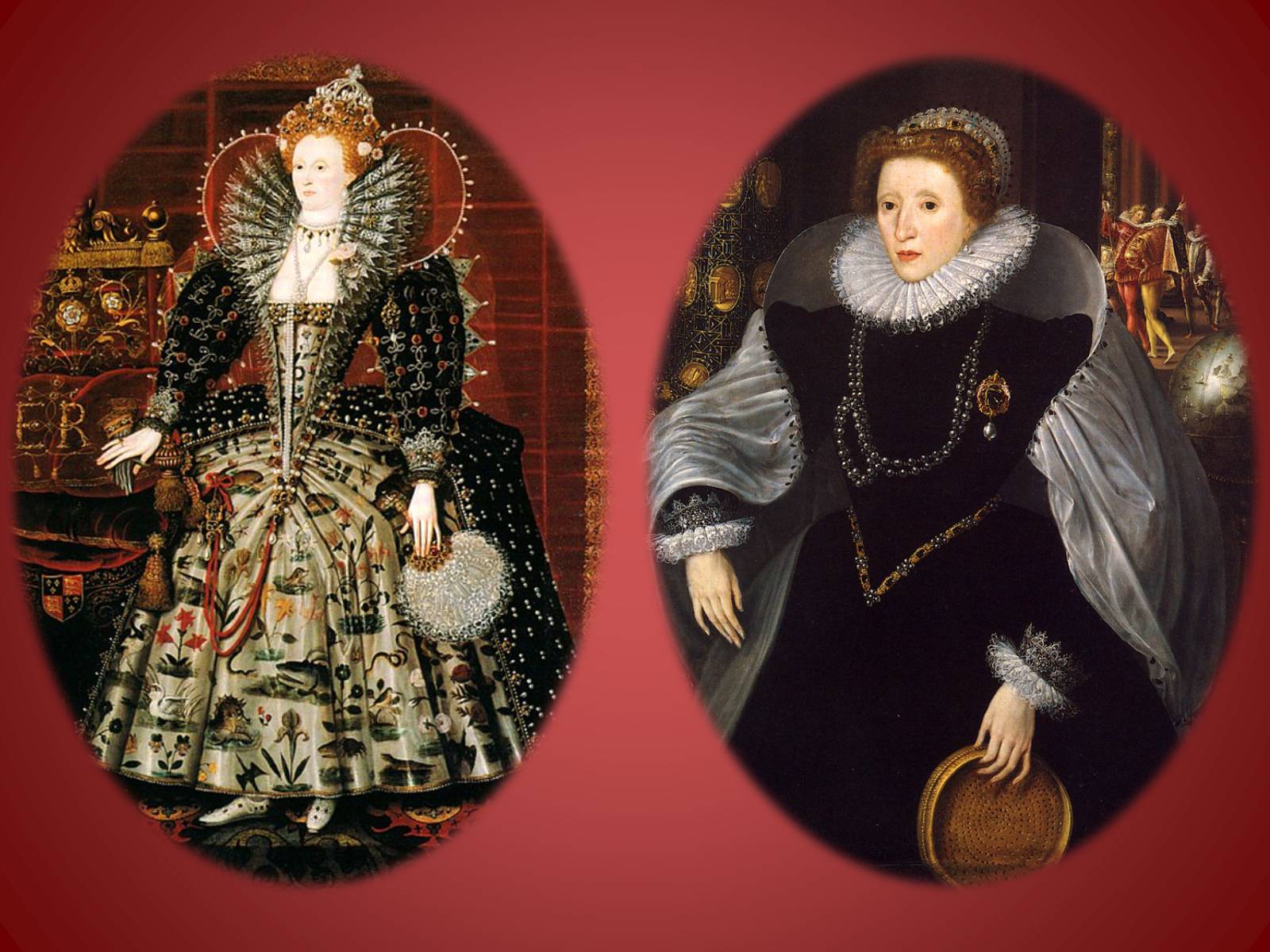
Слайд #31
Gallery
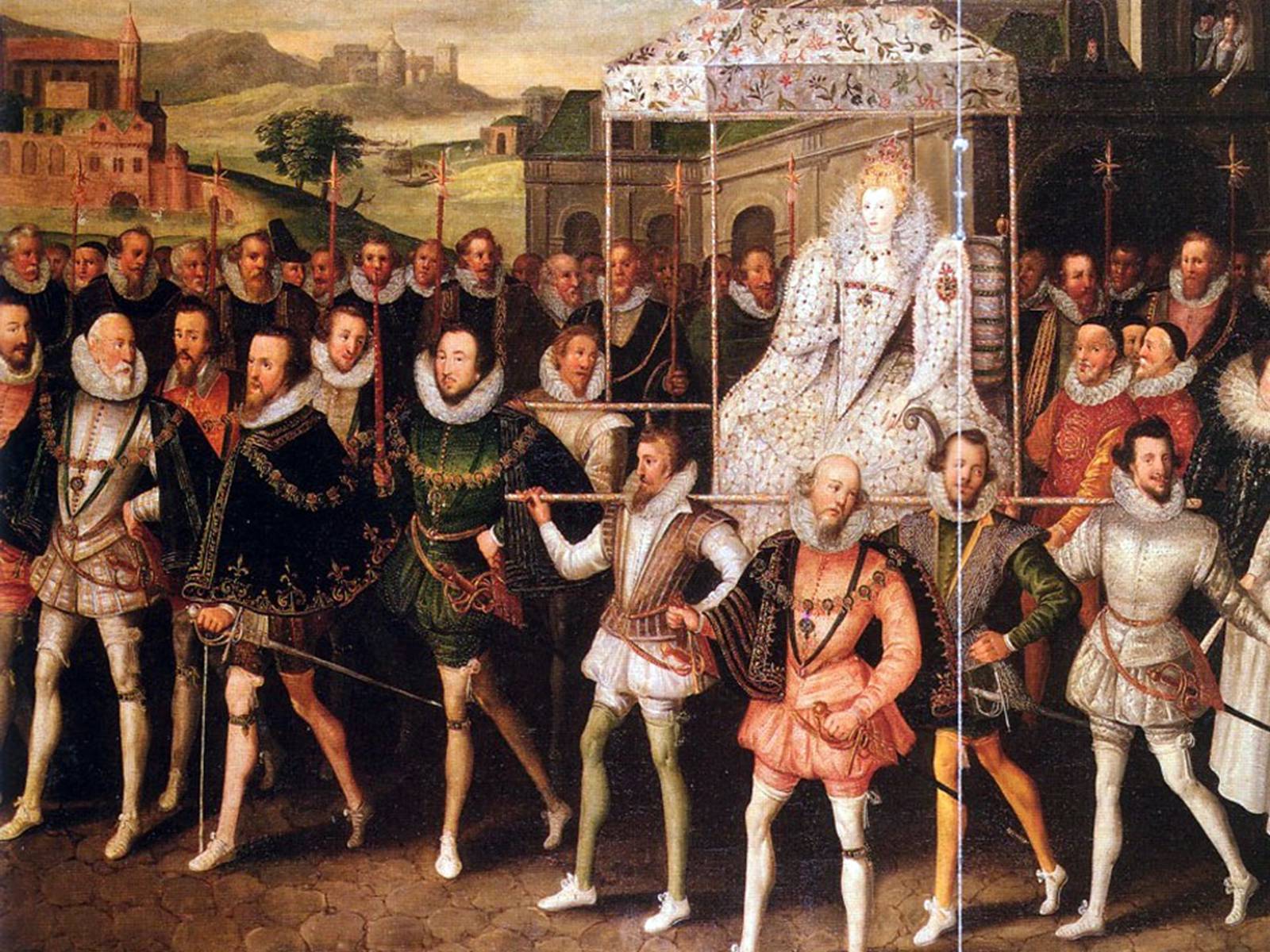
Слайд #32
Gallery
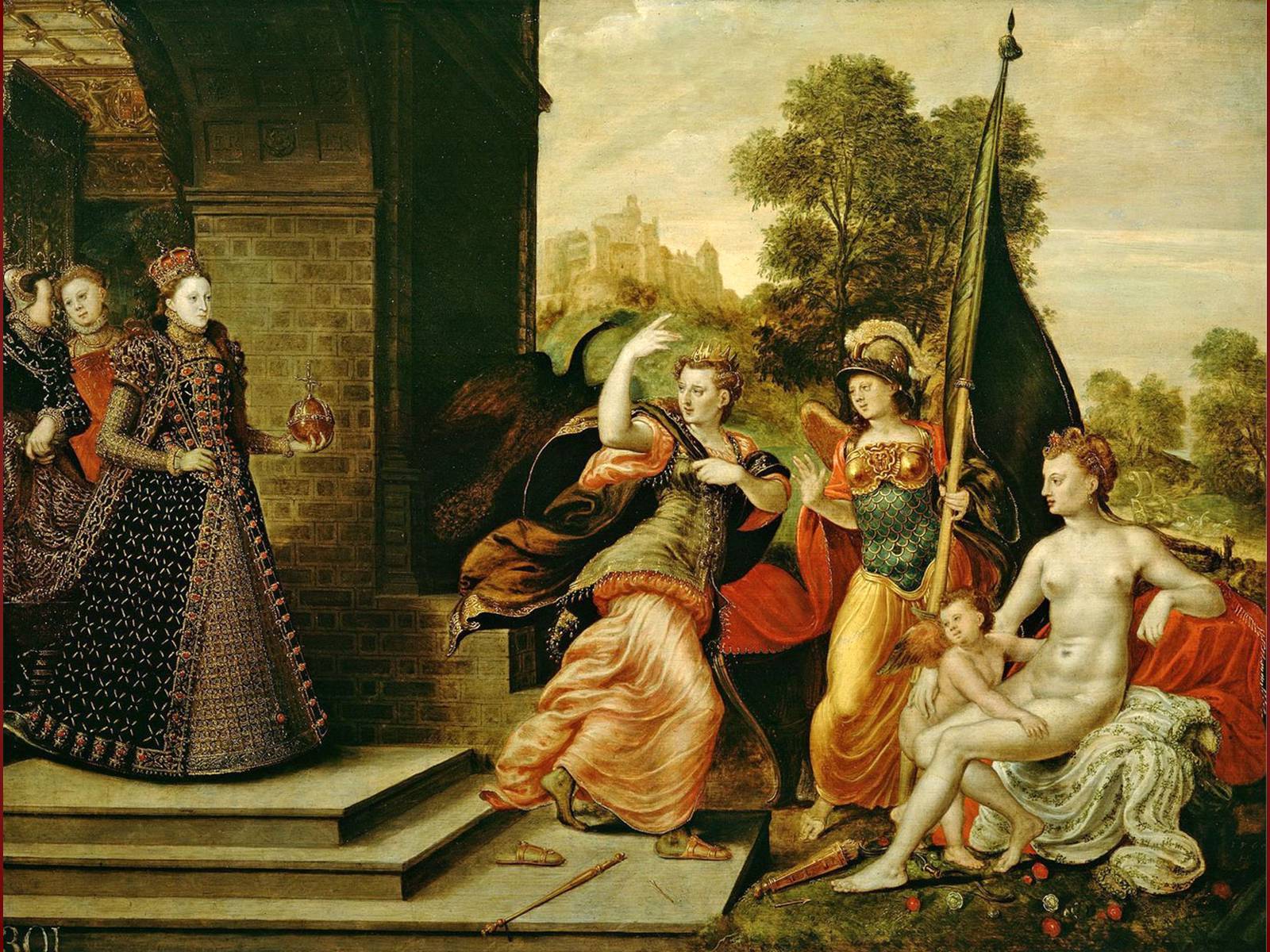
Слайд #33
Funeral procession.
K a t e
Fdorenko
K a t e
Fdorenko
